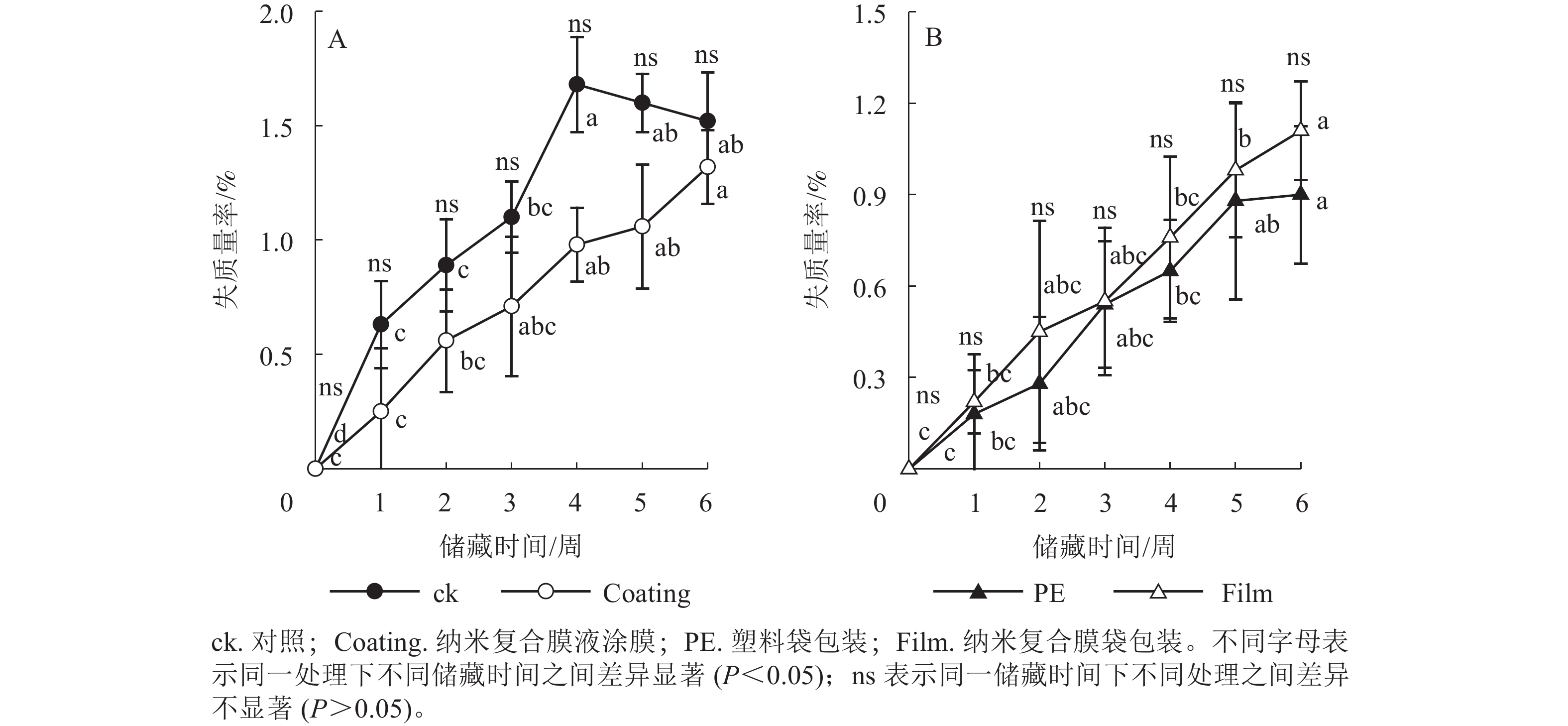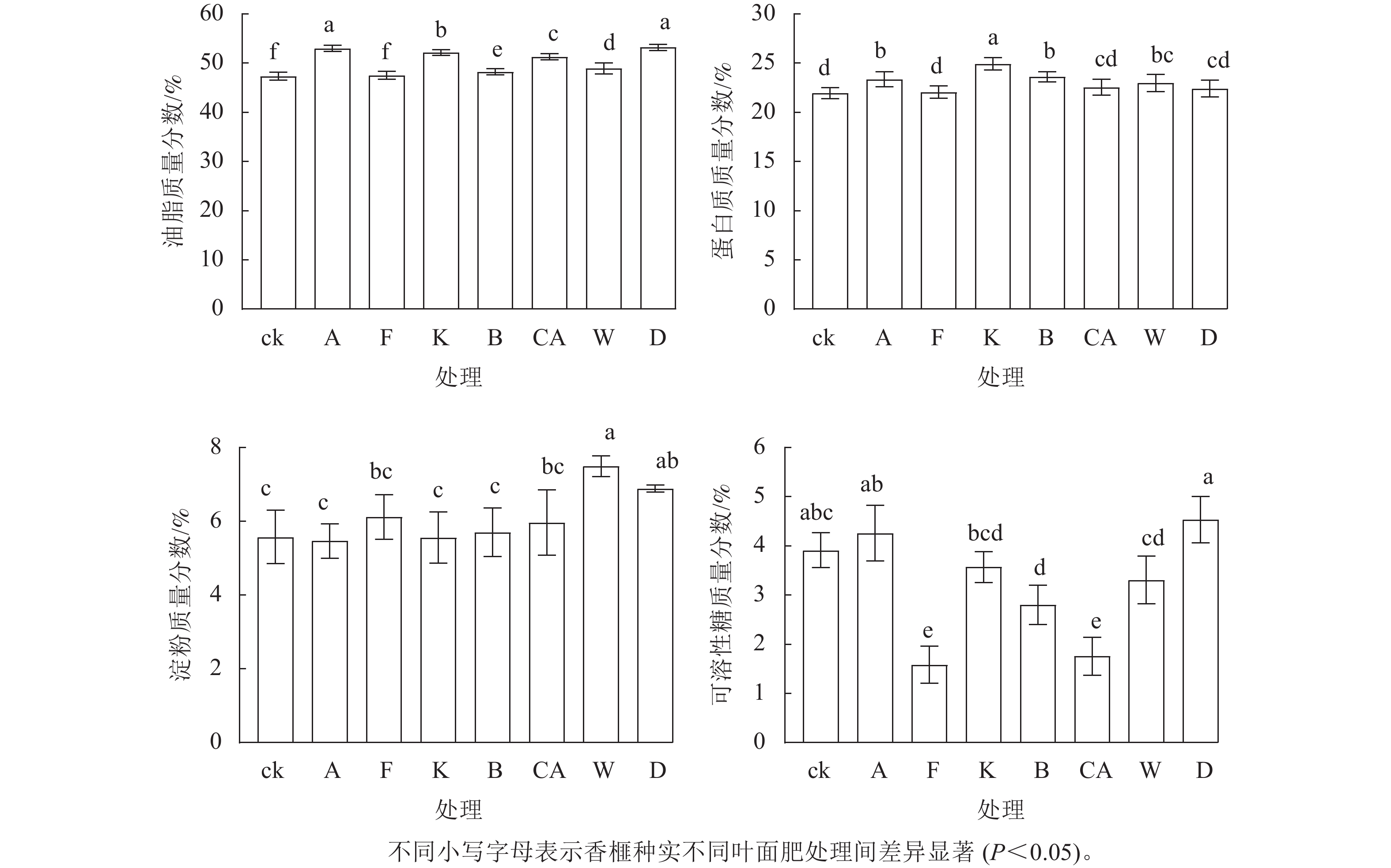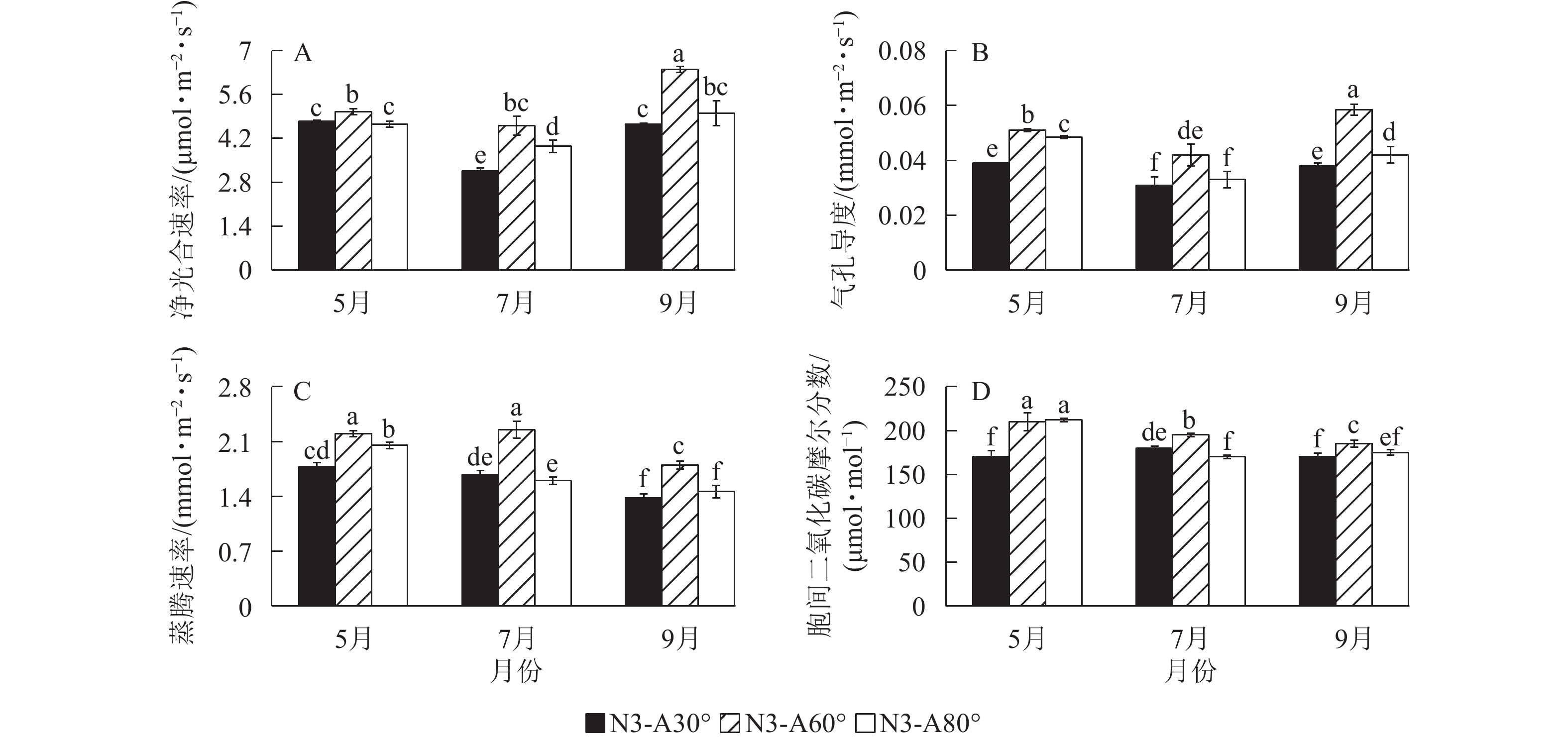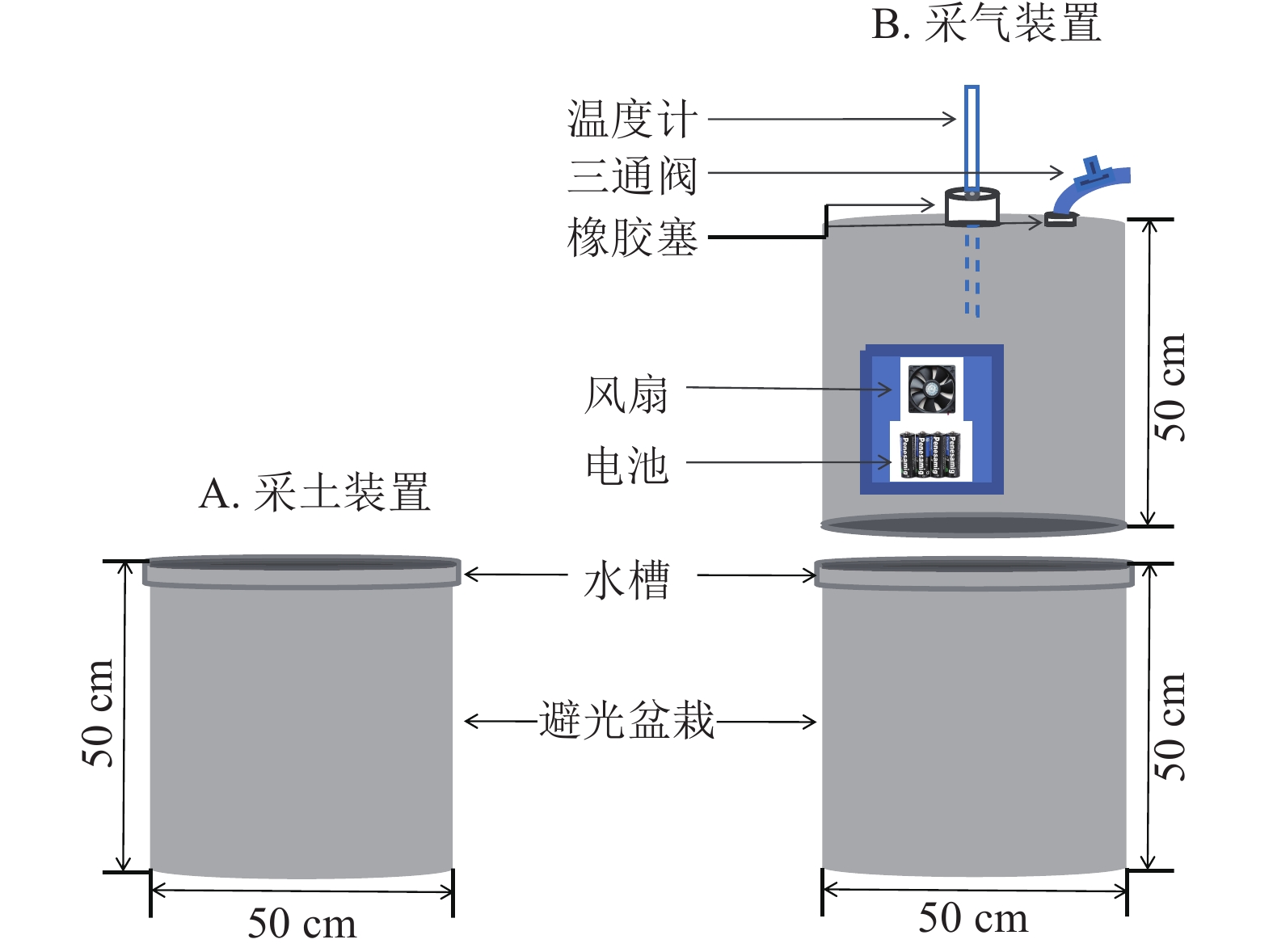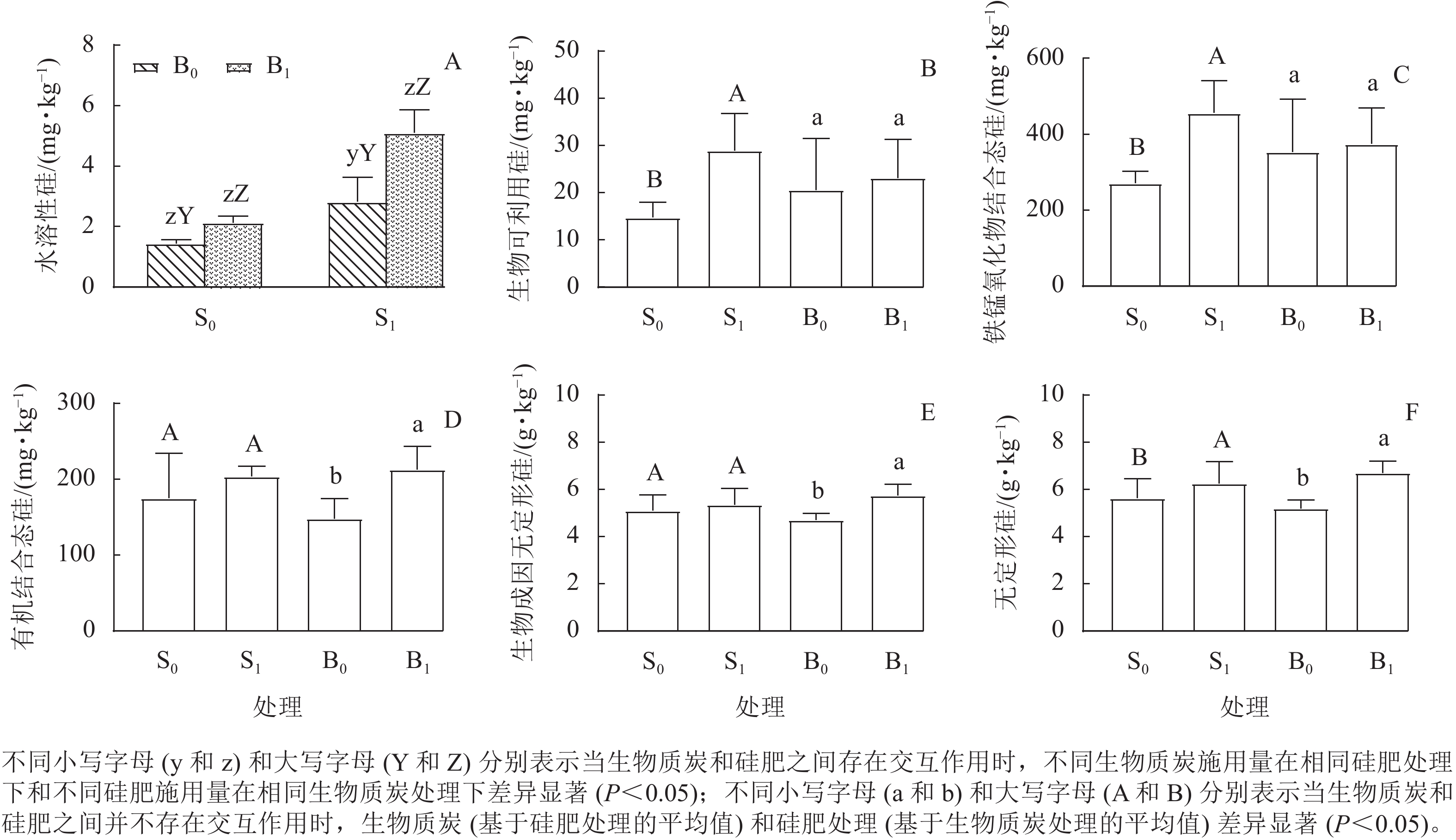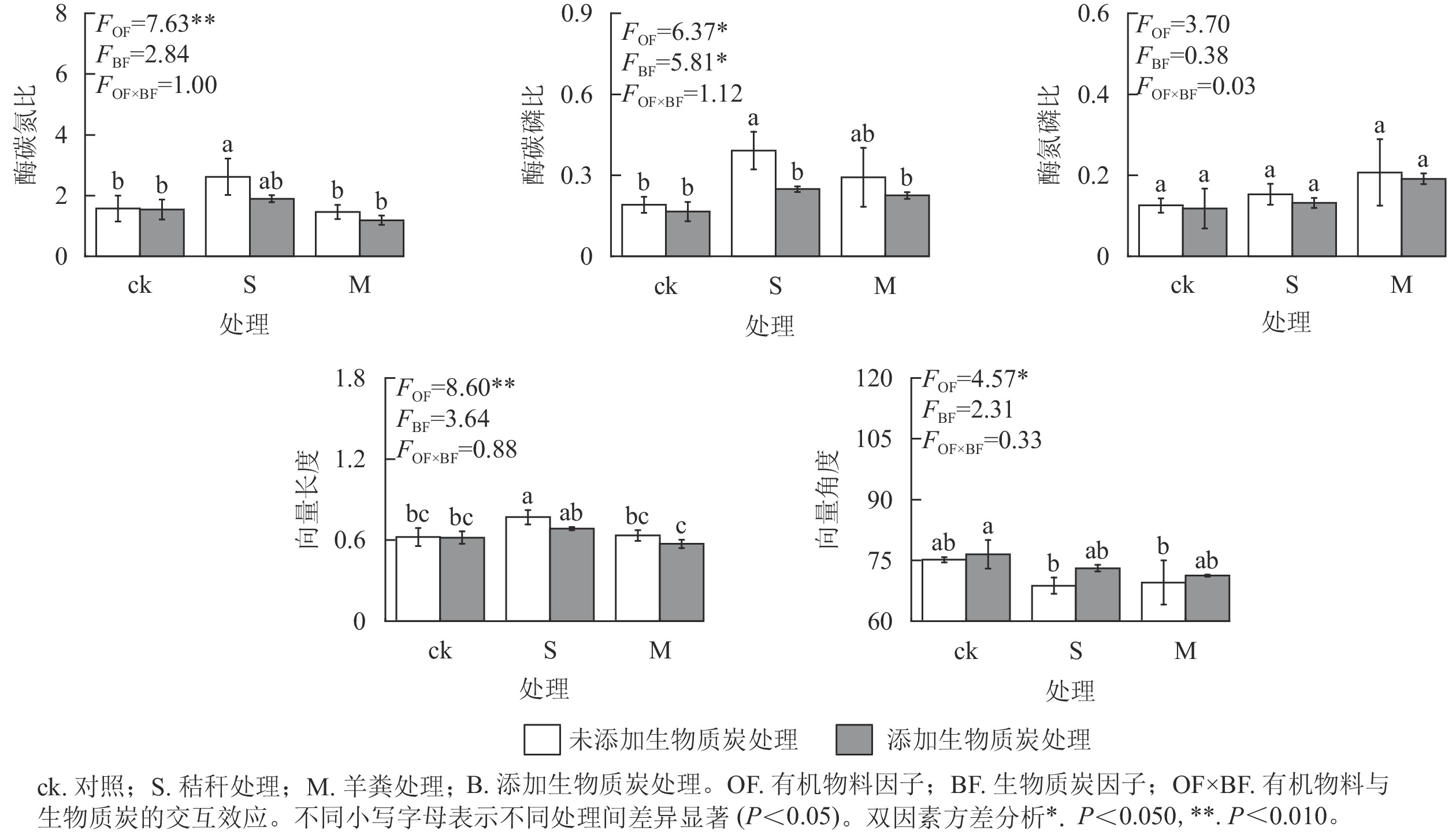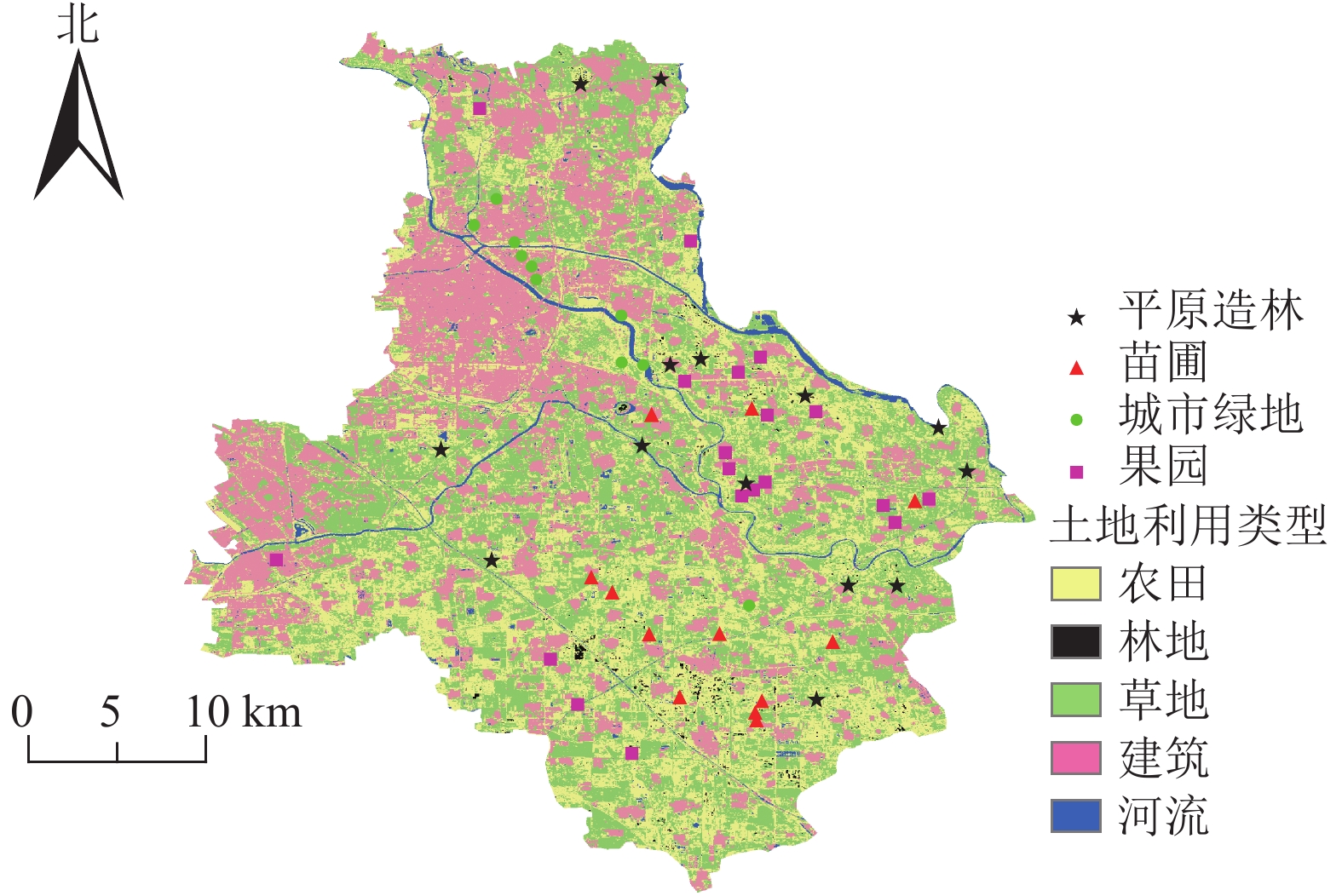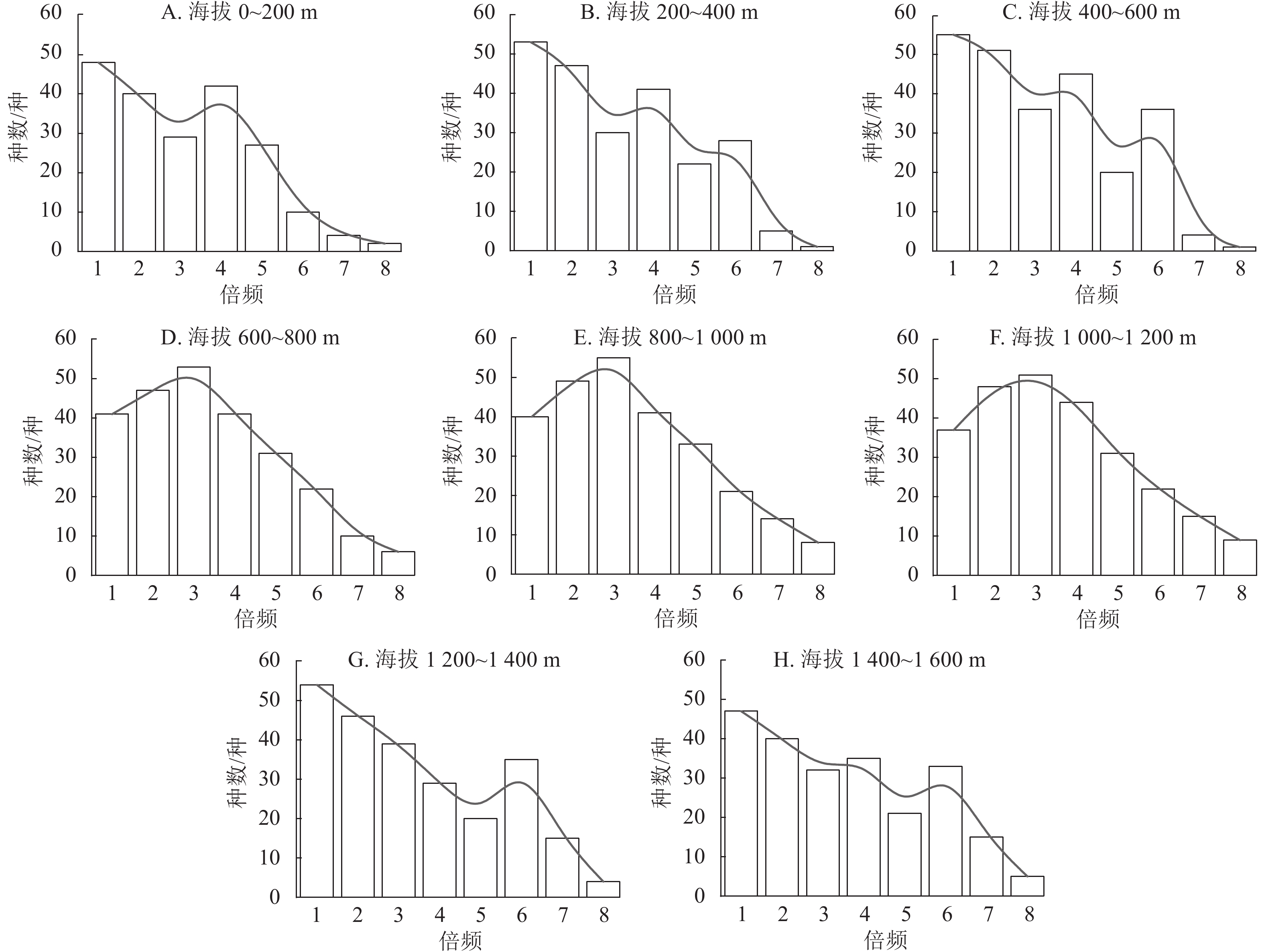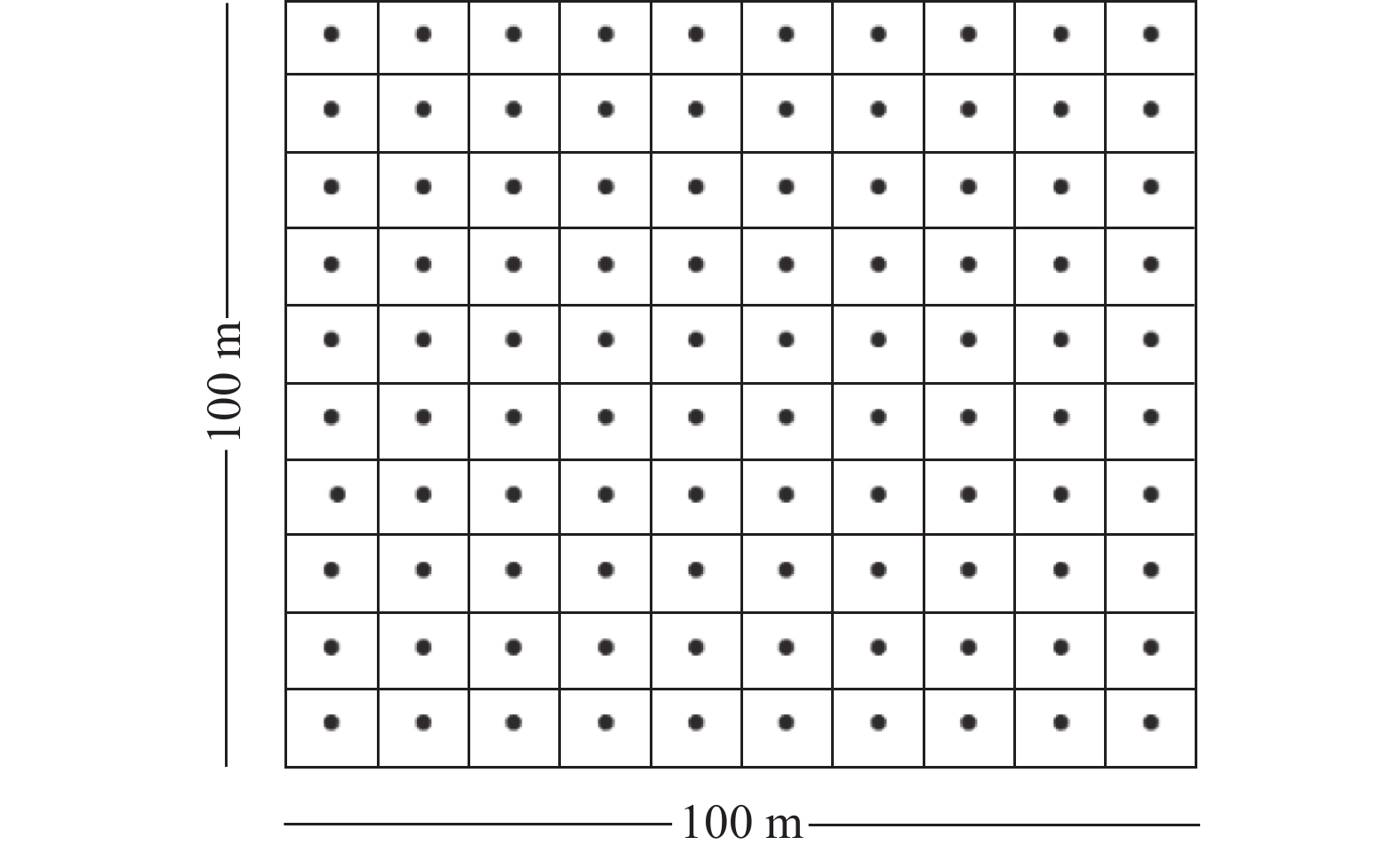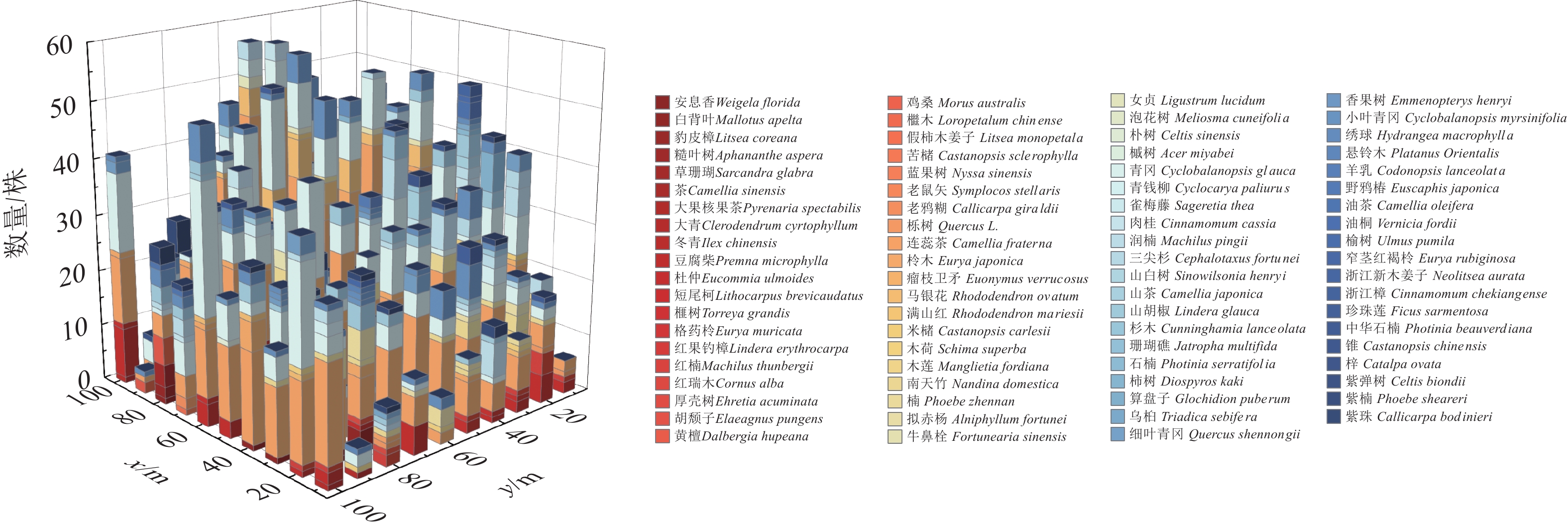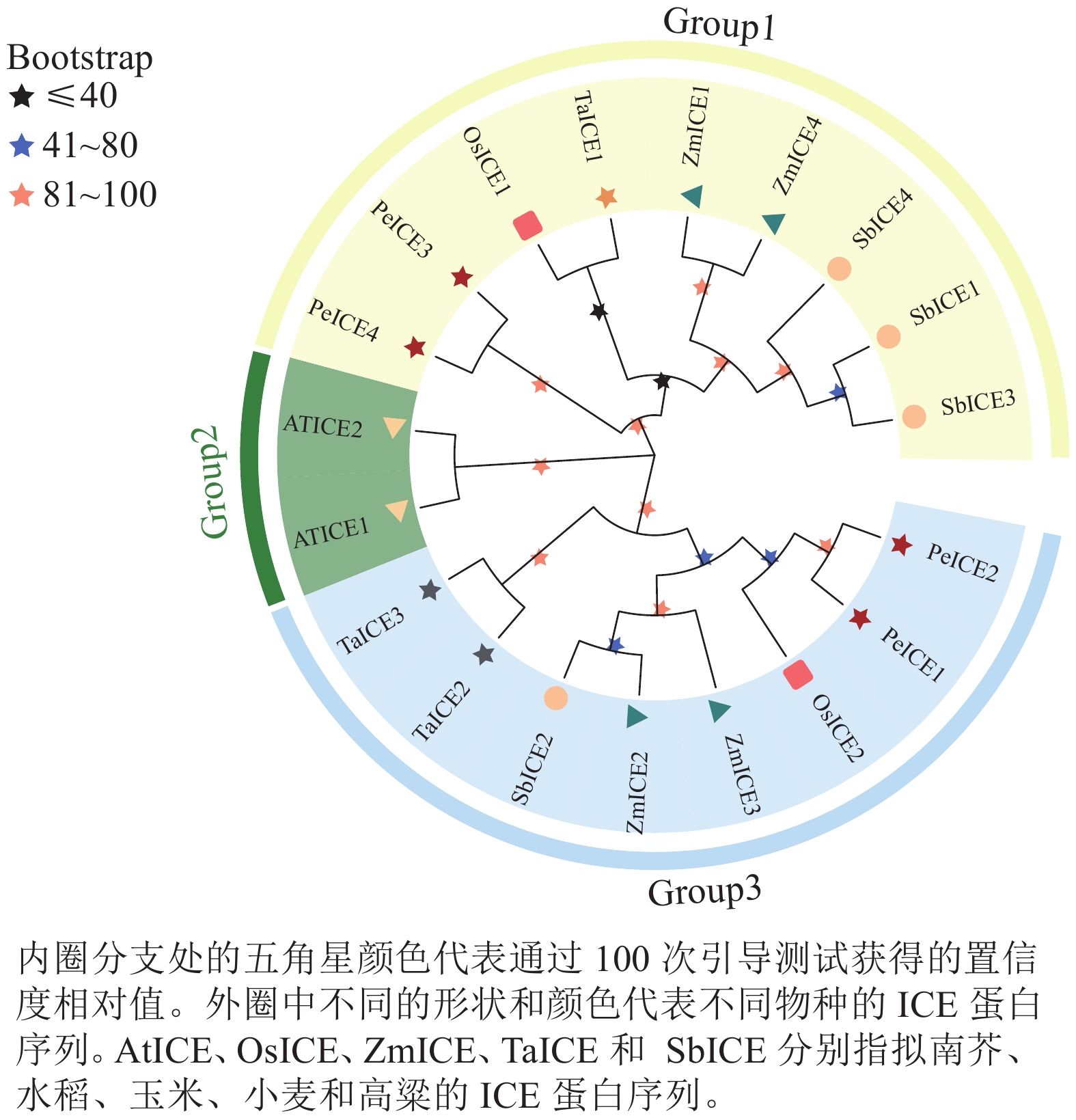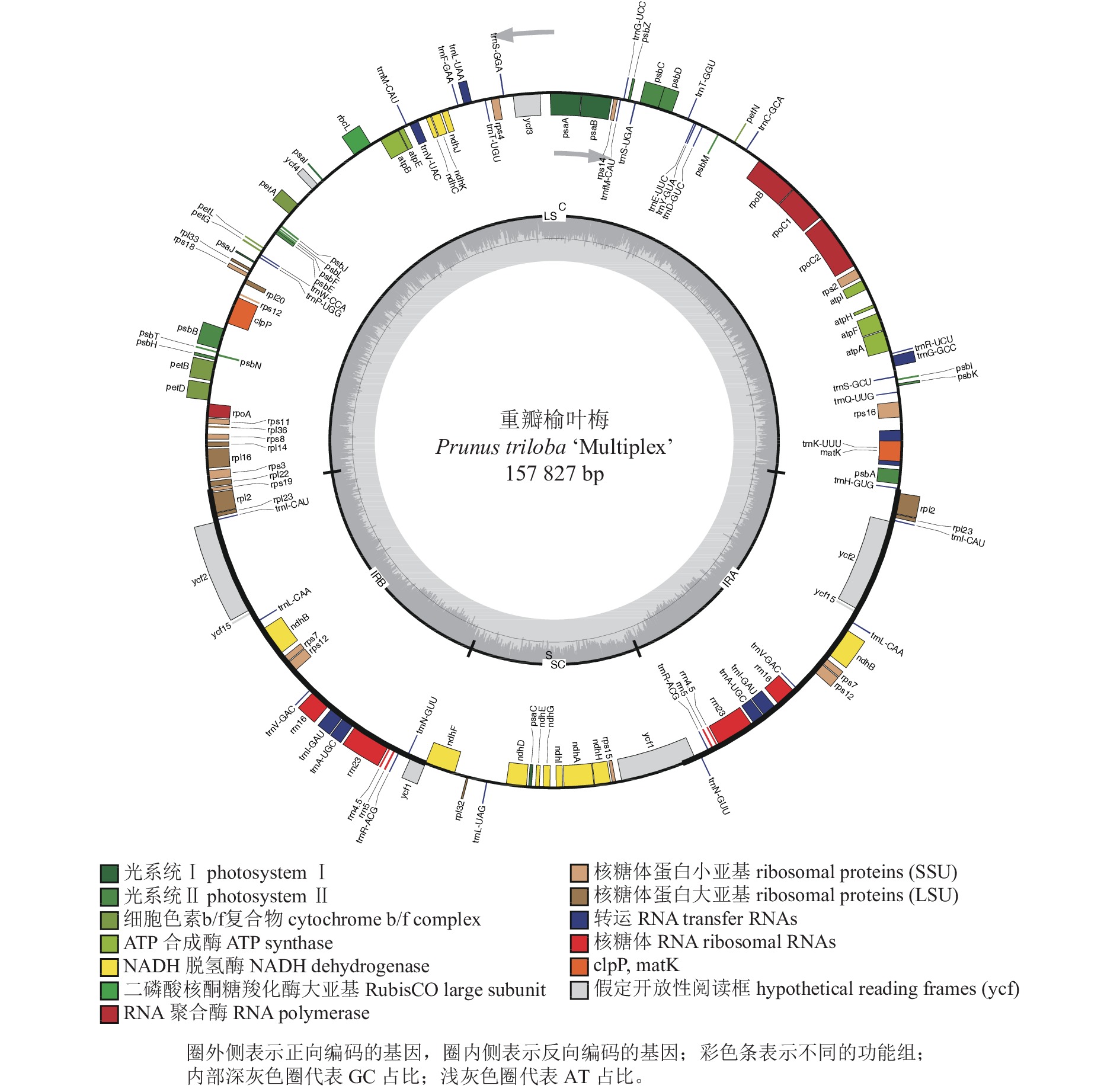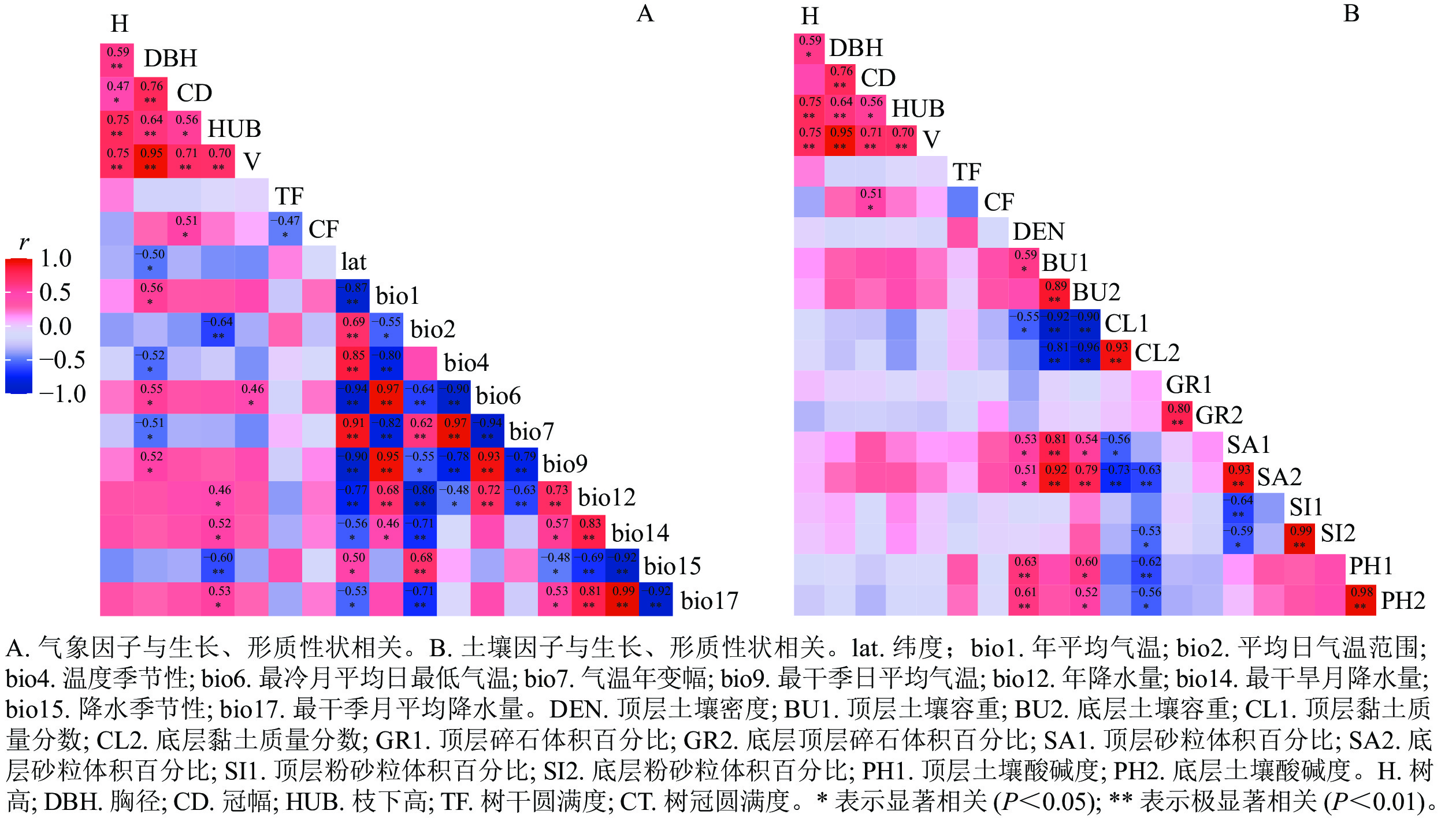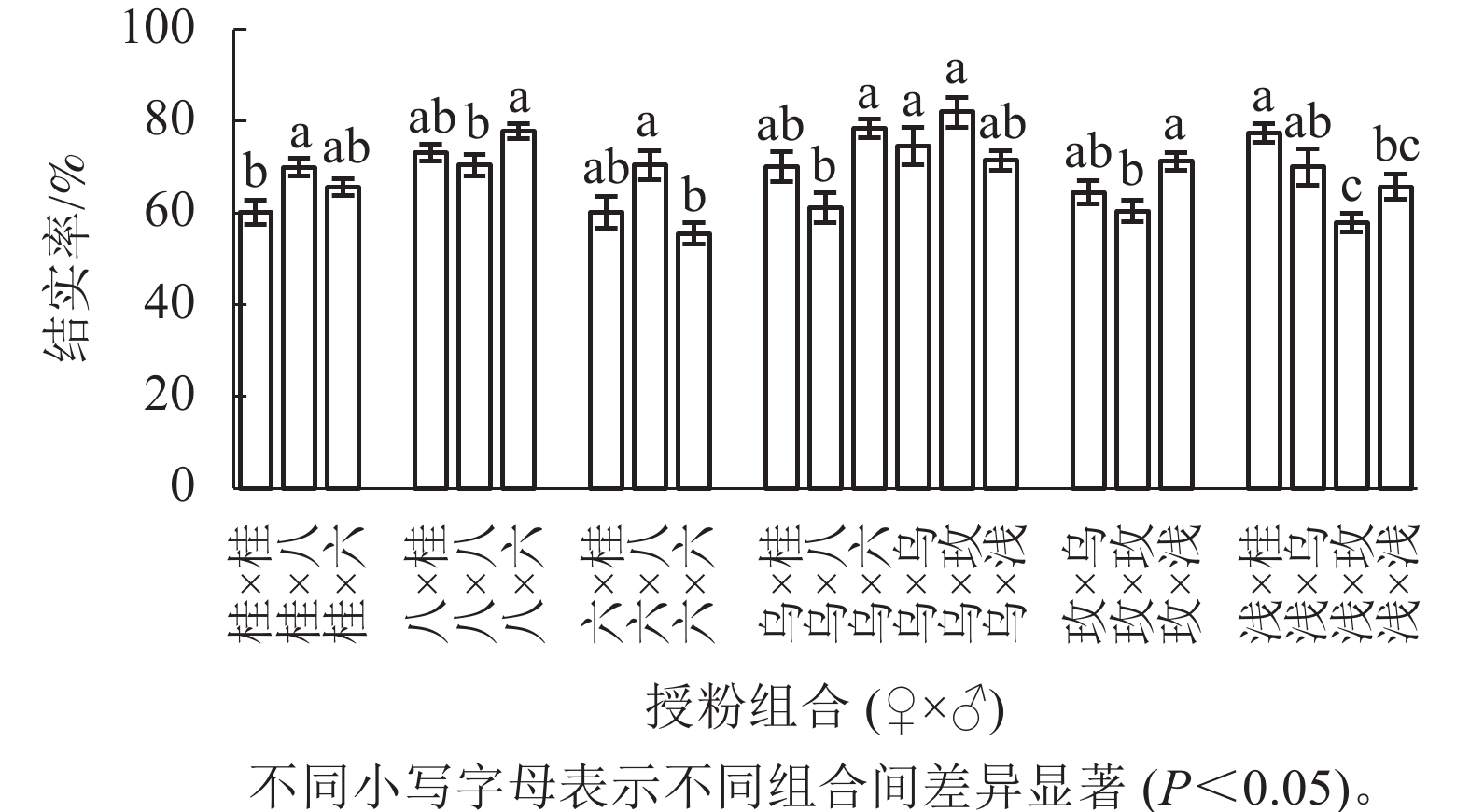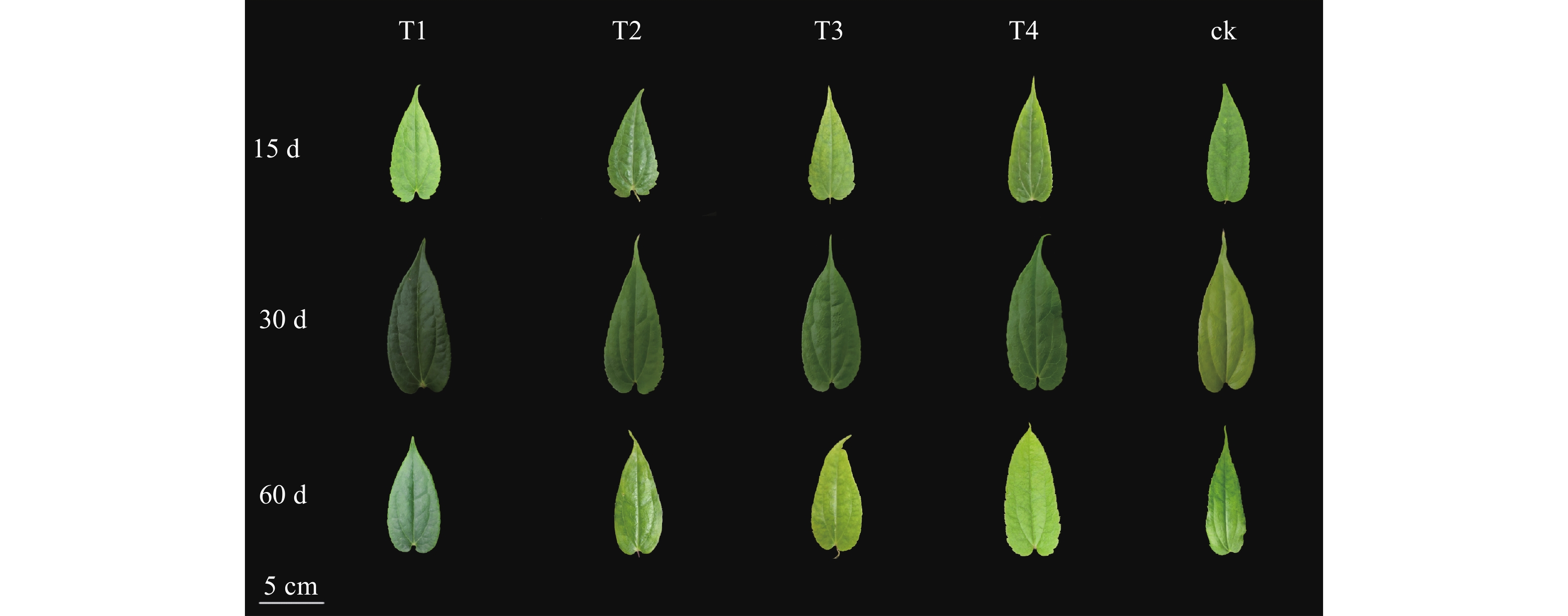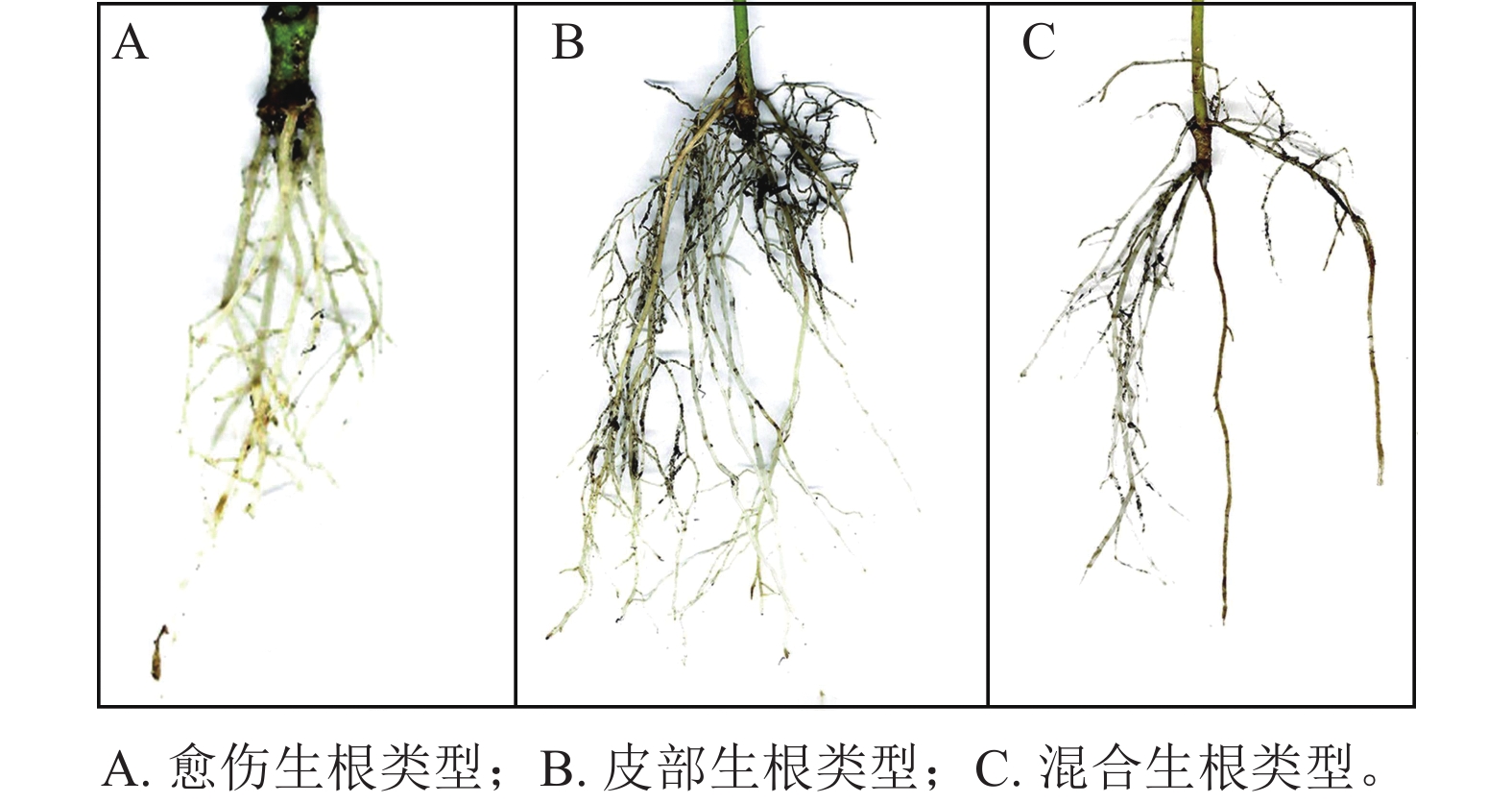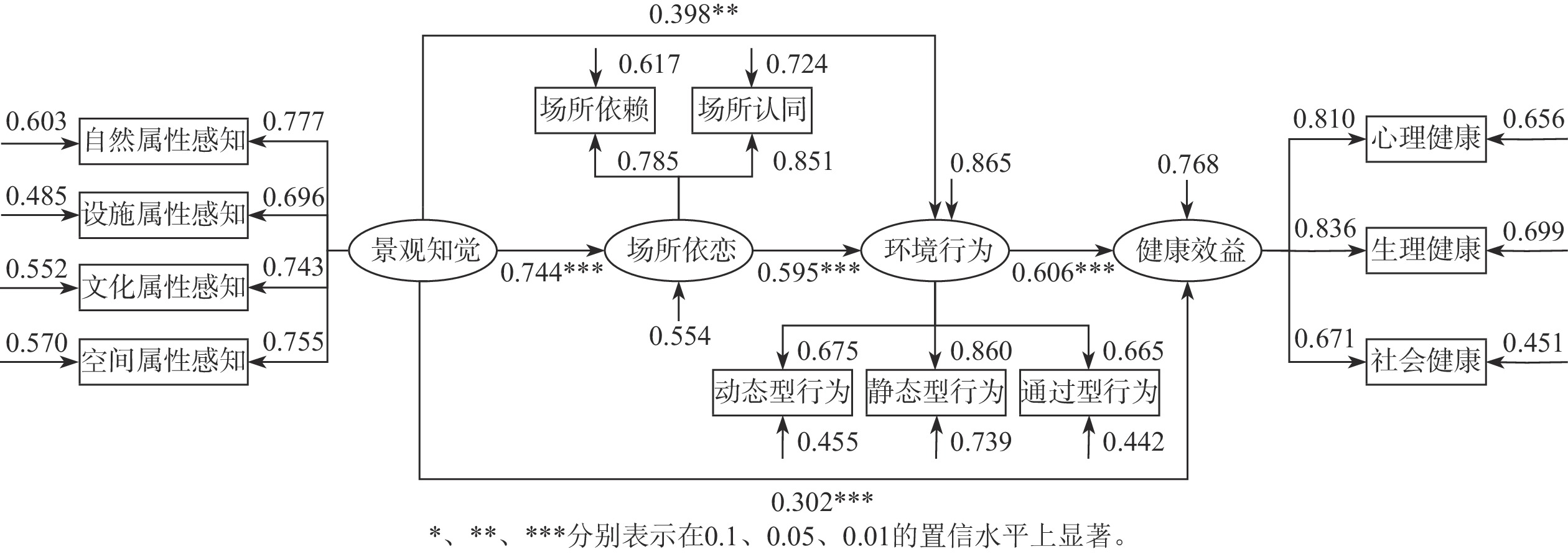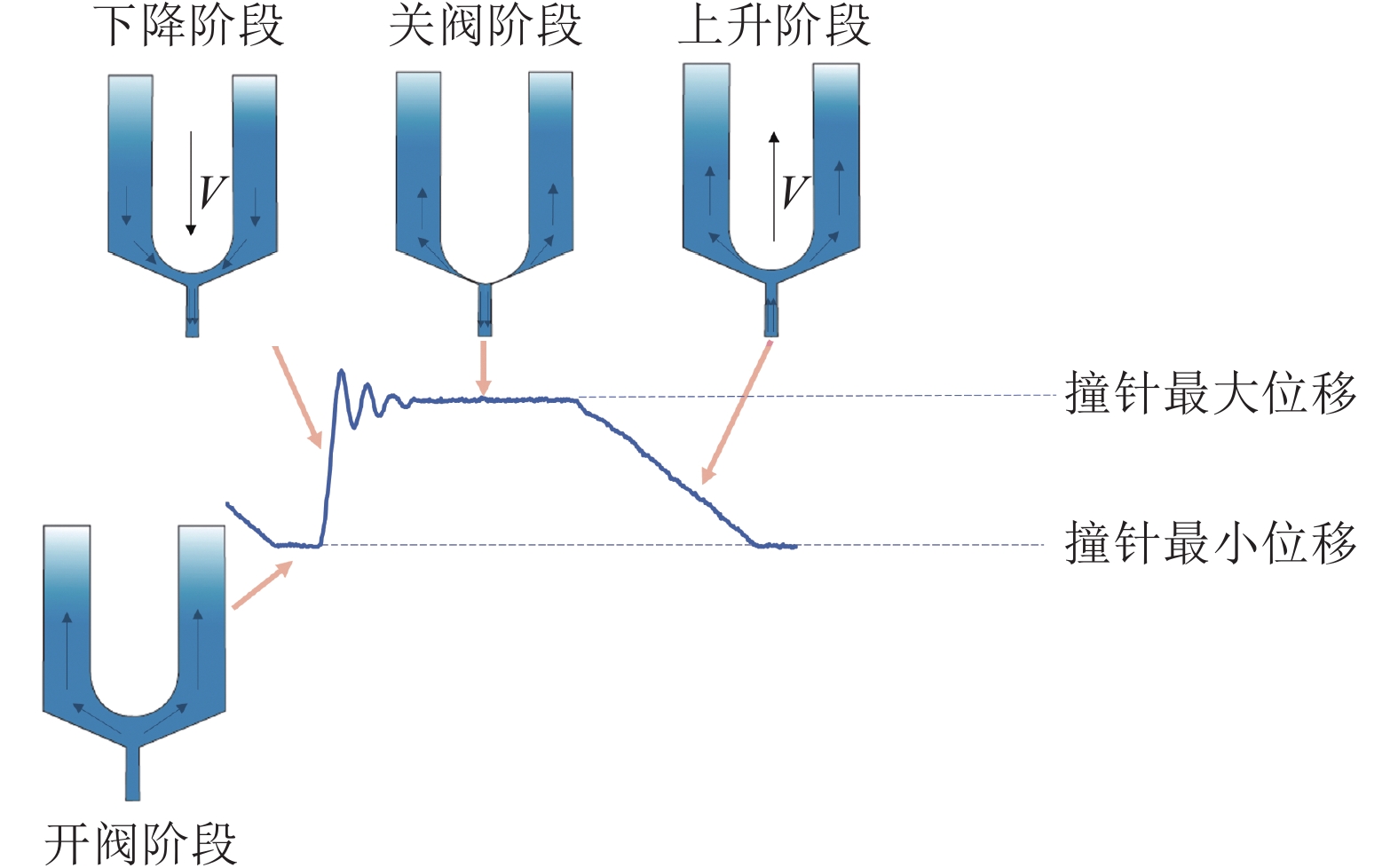2024 Vol. 41, No. 3
2024, 41(3): 447-456.
doi: 10.11833/j.issn.2095-0756.20240177
Abstract:
Objective This study aims to study the changes of oil quality in nano-film packaged Torreya grandis ‘Merrillii’ nuts during storage, and provide theoretical basis for searching new packaging material. Method The nanocomposite film solution prepared from pseudoseed residue after essential oil extraction and its essential oil were used as packaging raw materials. The oxidation experiment of the nuts during storage (0−6 weeks) was conducted by Schaal oven method. Two packaging types were set up (direct coating: control, short for ck; nanocomposite film solution coating, short for Coating; film bagged: plastic bag, short for PE; nanocomposite film bag, short for Film). Result (1) During 4 to 6 week of storage time, the iodine value of the nuts with Coating was significantly higher than that of ck (P<0.05), but it of the nuts with Film was significantly lower than that of PE (P<0.05). (2) During 5 to 6 week of storage time, the lipid oxidase activity, peroxidation value, carbonyl value and thiolbarbituric acid content of the nuts with Coating were significantly higher than those of ck (P<0.05), and the above indicators of the nuts with Film were significantly lower than those of PE. (3) PCA analysis showed that there was no obvious separation between the nuts with Coating and Film, however, the two treatments clearly separated from PE and ck. Conclusion The newly prepared nanocomposite film solution, whether directly coating or film bagged can significantly delay the rancidity of the nuts, with better oil quality during storage. [ Ch, 6 fig. 36 ref.]
2024, 41(3): 457-466.
doi: 10.11833/j.issn.2095-0756.20230194
Abstract:
Objective This study aims to explore aspects of Torreya grandis ‘Merrillii’ seeds, including appearance, nutritional quality, element content, flower bud differentiation, and expansion and fruit setting, so as to provide a theoretical basis for supplementing tree nutrition and improving seed quality. Method During the seed filling period of T. grandis ‘Merrillii’ from June to August, the seeds were treated with water as a control and sprayed with 7 commercial foliar fertilizers (amino acid water-soluble fertilizer, fulvic acid water-soluble fertilizer, active potassium water-soluble fertilizer, high-strength calcium water-soluble fertilizer, liquid boron water-soluble fertilizer, trace element water-soluble fertilizer, and macro-element water-soluble fertilizer). Physiological indicators of seeds in terms of seed morphology, oil content and fatty acid composition, crude protein content, starch content, soluble sugar content, and flowering intensity were measured and their effects on seed quality were analyzed. Result Spraying amino acid water-soluble fertilizer and macro-element water-soluble fertilizer significantly increased (P<0.05) the kernel shape index, single kernel mass, nucleation rate, kernel type index, and single kernel mass of seeds, as well as oil content, soluble sugar content, and flowering intensity, and significantly reduced starch content. Among them, the single kernel mass of seeds treated with amino acid water-soluble fertilizer increased by 9.8% compared with the control, while the starch content decreased by 1.9%. The single kernel mass, oil content, and soluble sugar content of seeds treated with macro-element water-soluble fertilizer increased by 9.5%, 11.9%, and 15.9%, respectively, compared with the control. At the same time, spraying amino acid water-soluble fertilizer significantly promoted (P<0.05) the content of taxoleic acid in seeds, which increased by 15.9% compared with the control, while spraying macro-element water-soluble fertilizer significantly (P<0.05) increased the content of unsaturated fatty acids in seeds by 4.2% compared with the control. In addition, high-strength calcium water-soluble fertilizer had a significant promoting effect (P<0.05) on the increase of kernel yield, flowering intensity, and fruit setting rate, which were 3.3%, 17.1%, and 10.9% higher than the control. The active potassium water-soluble fertilizer significantly increased the protein content of seeds by 13.6% compared with the control. Principal component analysis showed that the comprehensive quality score of seeds treated with amino acid water-soluble fertilizer was the highest. Conclusion The amino acid water-soluble fertilizer treatment has the best effect, followed by high-strength calcium water-soluble fertilizer and macro-element water-soluble fertilizer. [Ch, 3 fig. 5 tab. 29 ref.]
2024, 41(3): 467-477.
doi: 10.11833/j.issn.2095-0756.20240178
Abstract:
Objective This study aimed to investigate the impact of adjusting the number and opening angle of skeleton branches of Torreya grandis ‘Merrillii’ on canopy light intensity and leaf photosynthesis. Additionally, it aimed to elucidate alterations in carbohydrate, oil content, and other components to reveal the effect of tree shape adjustment on seed quality and provide a scientific basis for the tree cultivation. Method Experiments with different numbers and opening angles of skeleton branches were conducted using single-factor and interactive treatments to examine canopy light intensity, leaf photosynthesis, and the contents of soluble sugar, starch, soluble protein, oil and fatty acid components. Result Adjusting the opening angle of skeleton branches significantly influenced canopy light intensity. Under the opening angle of 60°, the light intensity in the central and lower layers of the canopy notably increased (P<0.05) from May to September, peaking at 40 klx in the central layer in July. However, an excessively wide opening angle of 80° led to a decrease of canopy light intensity. Under the interactive treatment of different numbers and opening angles of skeleton branches, the net photosynthetic rate, stomatal conductance, and transpiration rate of the leaves significantly increased in May, July and September (P<0.05). Carbohydrate analysis revealed that the contents of soluble sugar and starch in seeds under 3 and 4 branches with the opening angle of 60° adjustment (N3-A60° and N4-A60°) were significantly increased (P<0.05). The content of soluble sugar and starch in the seeds reached 609.05 and 576.63 mg·g−1, respectively. Furthermore, tree shape adjustment significantly promoted the accumulation of soluble protein and oil in the seeds. Conclusion The tree shape adjustment of T. grandis ‘Merrillii’ can enhance the canopy light intensity, leaf photosynthesis and seed quality, and the 3 and 4 skeleton branches with the opening angle of 60° has the best promotion effect. [Ch, 2 fig. 7 tab. 38 ref.]
2024, 41(3): 478-485.
doi: 10.11833/j.issn.2095-0756.20230471
Abstract:
Objective This study, with an exploration of the rooting differences and the physiological differences in response to drought stress between male and female Torreya grandis ‘Merrillii’, is aimed to provide a scientific basis for the cultivation of drought-resistant germplasm resources of T. grandis ‘Merrillii’. Method First, with the shoots of newborn male and female T. grandis ‘Merrillii’ selected as materials, a comparison is conducted of the differences in rooting of summer cuttings between them. Then, PEG solution was applied to male and female T. grandis ‘Merrillii’ with consistent rooting status for simulated drought treatment after which the changes of antioxidant enzyme activity, osmomodulating substances, membrane lipid peroxidation and reactive oxygen species content of male and female seedlings were compared and analyzed under different treatment times. Result The survival rate of male T. grandis ‘Merrillii’ of summer cuttings was generally higher than female and the best time for cuttings was different for male and female T. grandis ‘Merrillii’. Cuttings for the female in June had higher survival, rooting rates and a higher number of lateral roots than those in July and August whereas the survival rate and rooting rate of male cuttings in August were higher than those in June and July, and the number of lateral roots was higher. When the male and female T. grandis ‘Merrillii’ were cut for the same number of days, the survival rate and rooting rate of male plants were higher than the female ones. Drought stress caused significant changes in antioxidant enzyme activity in fragrant leaves, and disturbed its osmoregulatory function and reactive oxygen species metabolism balance. Under drought stress, female plants had higher superoxide dismutase (SOD) activity, peroxidase (POD) activity and catalase (CAT) activity, as well as lower malondialdehyde (MDA), proline (Pro), superoxide anion (O2−) and hydrogen peroxide (H2O2) than male strains. Conclusion The male T. grandis ‘Merrillii’ of summer cuttings have a higher survival rate of cuttings than female, and under drought stress, the female T. grandis ‘Merrillii’ can better use the antioxidant system to reduce the accumulation of reactive oxygen species and cell damage caused by drought stress. Thus, the female T. grandis ‘Merrillii’ are more drought-tolerant than male ones. [Ch, 4 fig. 1 tab. 28 ref.]
2024, 41(3): 486-495.
doi: 10.11833/j.issn.2095-0756.20230369
Abstract:
Objective The objective is to understand the effects of earthworm activity on soil CO2 emission and labile organic carbon change in Phyllostachys edulis forest, which is crucial to comprehending the role that soil fauna plays in the carbon cycle of P. edulis forest. Method Three treatments including ck (control, P.edulis), MBL (P.edulis with litter) and MBLE (P.edulis with litter and earthworms) were employed to conduct a three-month greenhouse pot experiment. Static chamber-gas chromatograph was used to collect and analyze CO2 release from soil in different times. The contents of soil organic carbon (SOC), particulate organic carbon (POC), dissolved organic carbon (DOC), mineral-associated organic carbon (MAOC) and microbial biomass carbon (MBC) were measured. Result The activity of earthworms significantly increased the biomass of P. edulis by 20.3% (P<0.01), and the response of soil CO2 emission to earthworm activity was sensitive to changes over time. There was no significant difference in CO2 emissions between MBLE treatment and MBL treatment in the early stage of the experiment (<51 d). However, in the later stage of the experiment (>51 d), the cumulative CO2 emission under MBLE treatment was significantly higher than that under MBL treatment (P<0.05). On the 85th day, the cumulative CO2 emission under MBLE treatment increased only by 4.5% compared with MBL treatment. The soil CO2 emission flux under MBL treatment increased by 25.2% compared with MBLE treatment. The impact of earthworm activity on soil carbon mass fraction was also varies over time. The contents of SOC, DOC, POC and MAOC under MBLE treatment were lower than those under MBL treatment in the first 68 days, while the MBLE treatment significantly increased DOC content by 15.2% on the 85th day (P<0.05). SOC content, MAOC content, and POC content increased by 8.5%, 8.5%, and 10.6%, respectively. MBC content significantly reduced 26.3% at the end of the experiment (P<0.01). Conclusion Earthworm activity can promote the growth of P.edulis, increase soil carbon content, and reduce soil CO2 emission flux and cumulative emissions at the end of the experiment. [Ch, 3 fig. 2 tab. 47 ref.]
2024, 41(3): 496-505.
doi: 10.11833/j.issn.2095-0756.20230366
Abstract:
Objective This study aims to investigate the impact of applying silicon fertilizer and biochar on water-soluble silicon, bioavailable silicon, organically bound silicon, iron-manganese oxide bound silicon, amorphous silicon (biogenic and pedogenic), and total silicon mass fraction in Phyllostachys edulis forest soil, and analyze the relationship between soil water-soluble silicon, soil active silicon components and soil characteristics. Method Based on the factorial design, 4 treatments were used, including control (S0B0), application of silicon fertilizer at 450 kg·hm−2 (S1B0), application of biochar at 10 t·hm−2 (S0B1), and combination of silicon fertilizer and biochar (S1B1). Result Silicon fertilizer increased bioavailable silicon and iron-manganese oxide bound silicon. The addition of biochar increased the amorphous silicon reservoir (main effect). The combined application of silicon fertilizer and biochar increased the water-soluble silicon in soil. The addition of silicon fertilizer, biochar, and soil depth all changed the composition of soil active silicon and promoted their mutual transformation. There was a highly significant positive correlation between soil organic carbon mass fraction and soil active silicon component (P=0.002). In addition, the addition of silicon fertilizer could directly and indirectly improve soil water-soluble silicon, mediate the conversion of soil silicon components, and improve the solubility of soil active silicon pools. The addition of biochar improved the accumulation of water-soluble silicon in soil. On the one hand, it increased botanical silicon. On the other hand, it increased soil pH and the mass fraction of amorphous silicon in soil formation, and regulated the distribution of soil silicon in each component. Conclusion The application of silicon fertilizer and biochar promotes the accumulation of active silicon in soil and changes their mutual conversion in P. edulis forest, but the transformation pathways are different. [Ch, 4 fig. 5 tab. 41 ref.]
2024, 41(3): 506-516.
doi: 10.11833/j.issn.2095-0756.20230468
Abstract:
Objective The objective is to analyze the effects of biochar and organic amendments application on organic carbon composition and enzyme activities of red soil in arid areas, and investigate limiting characteristics of microbial nutrients, so as to provide a theoretical basis for improving the stability of red soil organic carbon. Method A field experiment with 6 treatments were set up, including a non-amendment control (ck), corn (Zea mays) straw and sheep manure single application and their combination with biochar (corn straw biochar). 2 years after the start of the experiment, soil organic carbon components, soil nutrient mass fraction, hydrolase activities and oxidase activities related to carbon, nitrogen and phosphorus cycling were determined. Result Compared with the single application of straw and sheep manure, the combination of biochar and its application significantly increased the mass fraction of soil organic carbon and available nitrogen (P<0.05), increased the soil carbon-nitrogen ratio (C∶N), carbon-phosphorus ratio (C∶P) and the mass fraction of recalcitrant carbon pools, and reduced soil organic carbon activity index. The application of organic amendments significantly increased the activities of β-D-cellobiosidase hydrolase (CB), β-1,4-N-acetylglucosacosidase (NAG) and peroxidase (PERO) (P<0.05). Compared with the single application of sheep manure, the combined application of biochar and sheep manure significantly reduced the β-glucosidase (BG) activity, leucine aminopeptidase (LAP) activity, NAG activity and acid phosphatase (PHOS) activity (by 50.9%, 32.1%, 45.3% and 40.0%, respectively, P<0.05). Compared with the single application of straw, the combined application of biochar and straw reduced the activity of polyphenol oxidase (PHOX) by 28.6% and PERO activity by 22.2%, but had no effect on the activity of other enzymes. Compared with the single application of straw, the combination of biomass charcoal and straw reduced the vector length. Compared with applying sheep manure alone, the combination of biomass charcoal and sheep manure had no significant effect on enzyme stoichiometry, vector length, and vector angle (P<0.05). PERO and PHOX were significantly negatively correlated with soil recalcitrant carbon pools, C∶N and C∶P (P<0.05). Redundant analysis showed that soil recalcitrant carbon pools, C∶N and C∶P were the main factors affecting soil enzyme activity and its stoichiometric characteristics. Conclusion Compared with the single application of organic materials, the combined application of biochar and sheep manure can better improve the nutrient and the size of recalcitrant carbon fraction in red soil in arid cropland, reduce the activity of carbon degrading enzymes, and alleviate microbial carbon and phosphorus limitation, and can be an effective measure to improve the microbial nutrient limitations and carbon sequestration capacity in red soil. [Ch, 2 fig. 3 tab. 44 ref.]
2024, 41(3): 517-525.
doi: 10.11833/j.issn.2095-0756.20230435
Abstract:
Objective The types of land use in Tongzhou District of Beijing have changed greatly. Heavy metals in the soil of green land were investigated, source analysis and risk assessment were carried out to understand whether the current use of green land meets the requirements of cleanliness and safety, and suggestions on risk prevention and control of heavy metals were given. Method The pH values and total amounts of heavy metals including Cd, Cr, Pb, Hg, As, Cu, and Zn in 60 surface soil samples from the study area were determined. Source apportionment was carried out using Principal Component Analysis and the Absolute Principal Component Scores-Multiple Linear Regression (APCS-MLR) receptor model. The assessment of heavy metal element pollution was conducted using the Geo-accumulation Index method and the Potential Ecological Risk Assessment method. Result The average contents of 7 heavy metals Cd, Cr, Pb, Hg, As, Cu and Zn in the soil were 0.53, 47.87, 11.95, 0.25, 6.71, 4.64 and 51.21 mg·kg−1, while the average content of the remaining elements were below the background. All of the samples’ heavy metal concentrations were less than the screening values for Soil Pollution Risk Control Standards for Agricultural Land (GB 15618 −2018). Principal component analysis demonstrated that Cd, Pb, Hg and As were influenced by human sources, including coal combustion, traffic pollution, industrial and agricultural activities pollution; Zn originated from natural sources and was related to the soil parent material; Cu and Cr were mixed sources reaulted by soil parent materials and agricultural pollution. The contribution rates of sources calculated by APCS-MLR were as follows, a certain amount of Cd accumulated on the surface came mostly from human sources (92%); Hg was from source 3 (29%), source 1 (17%), source 4 (13%), and there were also 35% unknown sources, which were suggested as mixed sources. Moreover, sources 1, 3, and 4 were all anthropogenic sources, while source 2 was a natural source. Environmental quality evaluation of green soil was investigated through the ground accumulation index, which illustrated that Cd and Hg performed a higher ecological risk response. Most of the comprehensive potential risk values in the study area were slight and medium potential ecological risks, only few points were belonged to severe ecological risks. Conclusion The study shows that the overall risk level of green land soil in Tongzhou District is in the middle and low risk. The main elements causing the risk are Cd and Hg, which are the priority control elements of ecological risk, and can be controlled from the control of coal burning, traffic and industrial emissions. [Ch, 5 fig. 4 tab. 32 ref.]
2024, 41(3): 526-534.
doi: 10.11833/j.issn.2095-0756.20230259
Abstract:
Objective The aim of this study is to simulate suitable habitat changes of snow leopards (Panthera uncia) under land use change before and after Natural Forest Protection Project (NFPP) and different climate scenarios, which has practical significance for rare animal conservation in alpine mountains. Method Total 22 environmental variables that might have an impact on the distribution of snow leopards were selected and the land use data in 2000 and 2020 were used to represent the changes in land use type before and after the implementation of NFPP. The maximum entropy model (MaxEnt) was used to simulate the distribution change of suitable habitats for snow leopards, and the potential suitable habitats for snow leopards in 2050 under two climate scenarios, namely RCP 4.5 and RCP 8.5, were simulated. Result Before the implementation of NFPP, the high suitable area of snow leopards in Qinghai Province was 117 900 km2, the medium suitable area was 119 600 km2, and the low suitable area was 229 600 km2. The total suitability distribution area was 467 100 km2 (accounting for 64.7% of the study area). After the implementation of NFPP, the high, medium, and low suitable areas of snow leopards were 117 800, 117 700 and 241 400 km2, respectively, and the total suitable area increased to 476 900 km2 (accounting for 66.0% of the study area). The simulation results of future scenarios showed that by 2050, the suitable habitat of snow leopards in Qinghai Province would generally show a trend of contraction and agglomeration, with a certain degree of decrease in the areas of high, medium and low suitable habitats compared with 2020. Among them, the medium suitable habitats would decrease by 1 400 and 7 200 km2 under RCP 4.5 and RCP 8.5 scenarios, respectively, while the high and medium suitable habitat area would decrease by 3 200 and 4 900 km2, respectively. Conclusion The land use changed from 2000 to 2020, with a slight increase in the suitable habitat for snow leopards, inferring that NFPP has not led to the expansion of sirable habitat for snow leopards. A future warming climate will have a negative impact on the suitable habitat for snow leopards. Therefore, forestry management departments should strengthen monitoring of snow leopard activities and develop conservation strategies in advance for endangered wildlife such as snow leopards under climate change. [Ch, 3 tab. 42 ref.]
2024, 41(3): 535-541.
doi: 10.11833/j.issn.2095-0756.20230469
Abstract:
Objective With the clarification of the relationships and temporal dynamics of large moth species in Mount Tianmu in Zhejiang Province, this paper aims to provide a theoretical basis for the insect investigation in Mount Tianmu. Method Large moth specimens were collected from Zhejiang Mount Tianmu National Nature Reserve at different altitudes during the four-month period from May to August in 2022 before a systematic analysis was conducted of them and their population temporal dynamics. Result A total of 3367 large moth specimens were collected, belonging to 269 species of 25 families. The dominant taxa were the families Geometidae, Crambidae, Sphingidae and Noctuidae. At the altitude ranges of 600 − 1 200 m, the Simpson index, Shannon index, Margalef richness index and Pielou uniformity index were high, and the overall correlation was positive. The species-multidegree curve of large moths tended to be lognormal distribution at this altitude gradient, and the rest of altitude gradients were consistent with the niche priority occupation hypothesis. The number of large moth species was the largest with the strongest stability in July. Conclusion The large moth species were sensitive to time in Mount Tianmu with the number of species and individuals of them increasing at first and then decreasing from May to August. Species diversity of large moths increased at first and then decreased with the increase of altitude, and the similarity coefficient between medium and low altitude gradients was at medium and high levels. [Ch, 3 fig. 4 tab. 20 ref.]
2024, 41(3): 542-548.
doi: 10.11833/j.issn.2095-0756.20230502
Abstract:
Objective In order to provide scientific basis for predicting the succession trend of forest community and protecting the species diversity of ecosystem in Tianshan, this study focus on the spatiotemporal distribution of seed rain and seed germination of Picea schrenkiana var. tianschabica (Tianshan spruce) in Tianshan, Xinjiang. Method Based on three sample plots, 1 hm2 each set in the Xinjiang agricultural university experimental forest farm, and a seed rain collector was set in the center of each 10 m×10 m sample plot by mechanical layout method, with a total of 100 collectors in each sample plot. Using variance/mean (Cx), negative binomial index (K), aggregation index David (I), and Cassie R M, index (CA), 4 evaluation methods to distinguish the spatial distribution state of seed rain. In addition, the seed germination experiment 1 000-grain seed mass, germination energy and germination rate were measured respectively. Result The peak period of seed falling of Picea schrenkiana var. tianschanica was from late September to mid-October. The total amount of seed rain in 2022 was significantly higher than that in 2021. The seeds of Tianshan spruce presented aggregation distribution at the spatial level based on 4 indexes, Cx reaching 2047.01, K reaching 1.02, I reaching 2 046.01, and CA reaching 0.99 respectively. The 1 000-grain mass of spruce seed in the peak period was significantly higher than in the initial stage and the end stage. There was no significant in seed gernination energy and gernination rates between the initial period and period, but were significantly higher than the ending time of the rain. [ Conclusio n ] The interannual variation characteristics of seed rain of Tianshan spruce obviously showed an aggregated distribution. The peak period of seed rain was from late September to mid-October, the 1 000-grain mass, the germination energy and average germination rate were the best during this period. [Ch, 5 fig. 1 tab. 29 ref.]
2024, 41(3): 549-556.
doi: 10.11833/j.issn.2095-0756.20230573
Abstract:
Objective This study, with an investigation of the ecological stoichiometry characteristics of plant-litter-soil in typical forest stands in the Loess Hilly Region of China, is aimed to reveal the main limiting nutrient elements for the growth and development of vegetation in the ecosystem in this region. Method With a natural secondary forest of Quercus liaotungensis as the control, a systematic analysis was conducted of the ecological stoichiometric characteristics and their correlation between tree leaves, branches, roots, litter and soil in the forest of Pinus tabuliformis, Robinia pseudoacacia and Platycladus orientalis in Loess Hilly Region. Result (1) The overall contents of C, N and P in different organs in typical stands were leaves>branches>roots, and compared with C content, the content of N and P varied greatly between different organs with the C content of P. tabuliformis organs being substantially higher than other forest stands (P<0.05) and the N contents of leaves, roots, litter and soil of R. pseudoacacia being significantly higher than other forest stands (P<0.05). (2) R. pseudoacacia leaf C/N and C/P were significantly lower than other forest stands (P<0.05), with N/P being between 14 and 16, while leaf N/P of all other stands was lower than 14 and litter N/P was lower than 25. (3) C and N contents of all plant organs in typical stands were prominently positively correlated with litter C and N content (P<0.05), while plant P was significantly negatively correlated with litter and soil P content; soil C content was significantly negatively correlated with litter C content (P<0.05) but positively correlated with litter N content (P<0.05) and there was a significant negative correlation between litter C/N, C/P and soil C/N, C/P and N/P respectively (P<0.05). Conclusion Plant growth and development and litter decomposition in typical stands in the loess hills were mainly limited by N. And R. pseudoacacia forests should be selected and protected in the vegetation restoration in the Loess Hilly Region as its growth rate is the highest and the litter is easier to decompose. [Ch, 3 fig. 1 tab. 30 ref.]
2024, 41(3): 557-567.
doi: 10.11833/j.issn.2095-0756.20230446
Abstract:
Objective The objective is to study the impact of site factors on forest regeneration in the mixed coniferous and broad-leaved forests in Mount Tianmu, and provide a theoretical basis for the management of subtropical mixed coniferous and broad-leaved forests. Method A mixed coniferous and broad-leaved forest in Mount Tianmu was taken as the research object. Spearman’s correlation analysis was conducted between forest regeneration factors, soil factors and terrain factors. One-way ANOVA was used to analyze the differences in forest regeneration among different soil and terrain factors. A linear regression model was constructed to quantitatively describe the relationship between forest regeneration and terrain and soil factors. Result (1) There were 79 species of mixed coniferous and broad-leaved forests in Mount Tianmu, among which the dominant species were Camellia fraterna, Cyclobalanopsis glauca, Lithocarpus brevicaudatus, Cyclobalanopsis myrsinifolia, Machilus pingii, Rhododendron ovatum, Torreya grandis, Lindera glauca, Eurya japonica, and Litsea coreana. (2) There was a highly significant negative correlation between available potassium and the total number of updated tree species (P<0.01), a highly significant positive correlation between altitude and the total number of updated tree species (P<0.01), a significant negative correlation between organic matter and the number of updated tree species (P<0.05), and a highly significant positive correlation between available potassium and the total number of updated tree species (P<0.01). (3) There was a significant difference in the total number of updated tree species with different slope orientations and available potassium levels (P<0.05). There were significant differences in the number of updated tree species with different grades of slope and soil organic matter (P<0.05). (4) In the linear regression model with the total number of upgraded tree species as the dependent variable, the regression coefficients of available potassium and altitude were significant (P<0.05). Conclusion In the mixed coniferous and broad-leaved forests in Mount Tianmu, altitude, slope, aspect, soil organic matter and available potassium have significant effects on forest regeneration. [Ch, 3 fig. 5 tab. 49 ref.]
2024, 41(3): 568-576.
doi: 10.11833/j.issn.2095-0756.20230445
Abstract:
Objective The ICE gene family of Phyllostachys edulis (moso bamboo) was identified and analyzed to find out the key family members responding to cold resistance of moso bamboo, and to lay a theoretical foundation for further research on the biological functions of moso bamboo ICE genes, the molecular mechanisms responding to low-temperature stress, and the genetic transformation to improve the cold resistance of moso bamboo. Method Bioinformatics methods were used to identify and analyze the ICE gene family members of moso bamboo, and to analyze the physiological indexes and the expression patterns of ICE genes in moso bamboo at 0, 0.5, 1.0, 24.0, and 48.0 h of low-temperature treatments at 4, 0 and −2 ℃. Result A total of four mosaic bamboo ICE genes were identified. Conserved structural domains and multiple sequence comparison analyses showed that their structures were highly similar. Phylogenetic relationships and promoter cis-acting element analyses showed that the PeICE gene was more closely related to rice, and a large number of cis-acting elements associated with abiotic stresses were also present. Reactive oxygen radical (superoxide anion) staining revealed that the ROS staining gradually deepened with the increase in treatment time, but its staining gradually weakened after 24.0 h of 0 ℃ treatment and 1.0 h of −2 ℃ treatment. Proline content and superoxide dismutase activity assays revealed an overall increase in Pro and SOD content at 4 ℃ and 0 ℃, but their expression was lower than the control at −2 ℃, and peroxidase activity assays revealed an increase at all three temperatures. Analysis of ICE gene expression pattern revealed that the overall expression of PeICE increased in 4 ℃ and 0 ℃ treatment, and the most obvious increase was in PeICE3. The overall expression level of PeICE was lower than that of the control at −2 ℃. Conclusion With the decrease of cold treatment temperature and the enhancement of treatment time, moso bamboo was subjected to increasing damage, and its in vivo enzyme activity system as well as ICE genes responded positively to cold stress, and PeICE3 was the most sensitive to cold stress, whereas the expression of ICE genes did not increase at −2 ℃, and this gene family maybe respond to low-temperature stress instead of freezing stress. [Ch, 7 fig. 1 tab. 42 ref.]
2024, 41(3): 577-585.
doi: 10.11833/j.issn.2095-0756.20230489
Abstract:
Objective To investigate the phylogenetic location of Prunus triloba ‘Multiplex’ and analyze its chloroplast gene composition characteristics, the whole chloroplast genome sequence of P. triloba ‘Multiplex’ was sequenced. Method The leaves of P. triloba ‘Multiplex’ were used as materials to extract chloroplast DNA using 2×CTAB method. The whole chloroplast genome was sequenced by Illumina NovaSeq platform. We then assembled, annotated, and analyzed the genetic characteristics of the chloroplast genomic sequence. Combined with the NCBI database data, the phylogenetic relationship of P. triloba ‘Multiplex’ was constructed based on the whole chloroplast genome sequence. Result The total length of the chloroplast genome of P. triloba ‘Multiplex’ is 157 827 bp, with NCBI registration number MT937181. The structure is a classic tetrad structure, consisting of 1 LSC (large single copy region), 1 SSC (small single copy region), and IRa/IRb (reverse repeat region), with sequence lengths of 86 032, 19 023 and 26 386 bp, respectively. The total content of GC and AT is 36.80% and 63.20%, respectively. The complete chloroplast genome sequence of P. triloba ‘Multiplex’ was annotated to 132 genes, including 37 tRNA genes, 87 coding protein genes, and 8 rRNA genes, respectively. The chloroplast genome of P. triloba ‘Multiplex’ encodes a total of 26 678 codons and 236 eligible SSR loci. The A/T base is dominant in the SSR site, and the base preference is very obvious. Conclusion The phylogenetic tree analysis showed that P. triloba ‘Multiplex’ and P. triloba aggregate into a branch structure, and are closely related to P. pedunculata in the same genus. The results of this study will provide new evidence and basic experimental data for species identification, phylogenetic evolution, and breeding and selection of P. triloba ‘Multiplex’. [Ch, 4 fig. 4 tab. 26 ref.]
2024, 41(3): 586-596.
doi: 10.11833/j.issn.2095-0756.20230368
Abstract:
Objective The purpose is to study the regulatory effect of LsMYB7 gene on the accumulation of anthocyanins in Lycoris sprengeri. Method R2R3-MYB transcription factor LsMYB7 was screened from petals of L. sprengeri. The expression of LsMYB7 and structure genes related to anthocyanin biosynthesis was analyzed by real-time quantitative PCR technology (RT-qPCR). The function of LsMYB7 on anthocyanin accumulation was studied by virus-induced gene silencing (VIGS) technology. Result A 951 bp LsMYB7 gene cDNA sequence was cloned from petals in L. srprengei, containing 825 bp open reading frame (ORF) which encoded 274 amino acids. LsMYB7 protein contained two R2 and R3 domain, and belonged to R2R3-MYB transcription factor family. Phylogenetic analysis showed that LsMYB7 was clustered one group with Arabidopsis thaliana S22 subfamily genes, involved in regulating responses to abiotic stress such as drought and high temperature. LsMYB7 was localized in the nucleus. The expression trend of LsMYB7 gene was consistent with genes related to anthocyanin biosynthesis in different flower development stages and different flower color clones, and mainly expressed in petals of H1 clones with high anthocyanin content and last flowering period. The petals of L. sprengeri became significantly shorter and darker in color, and the expression of genes related to anthocyanin biosynthesis, such as LsCHS, LsF3'H, LsANS, LsUFGT1, and LsUFGT2, was significantly downregulated after LsMYB7 gene being silenced. Conclusion LsMYB7 belongs to S22 subfamily of the R2R3-MYB transcription factor family, and gets involved in regulating the expression of genes (like LsCHS, LsF3'H, LsANS, LsUFGT1 and LsUFGT2) related to anthocyanin biosynthesis and promoting anthocyanin accumulation. [Ch, 9 fig. 1 tab. 31 ref.]
2024, 41(3): 597-605.
doi: 10.11833/j.issn.2095-0756.20230481
Abstract:
Objective The purpose of this study is to examine the provenance variations in growth, shape and quality traits of 10-year-old Toona sinensis, to reveal the variation of different traits in geographical provenance, and to carry out provenance division and selection. Method Using the 10-year-old T. sinensis provenance test in Kaihua County, Zhejiang Province as material, the tree height, diameter at breast height (DBH), height under the branch, crown width, volume, trunk completeness, and crown completeness were measured, and various ecological and environmental factors were obtained. Variance, principal component, correlation, and cluster analysis were applied to calculate the general heritability, comprehensive selection index, and genetic gain to elucidate the geographical variation patterns of growth, shape, and quality traits and their relationship with ecological factors of different origin. Result There were significant provenance differences (P<0.01) in tree height, DBH, trunk completeness, and volume. The DBH, tree height, crown width, height under branches, and volume of the provenances displayed typical zonal variation patterns. There was a highly significant positive correlation (P<0.01) between DBH and crown width, height under branches and volume. DBH was positively correlated (P<0.05) with the annual mean temperature, the average daily minimum temperature in the coldest month, and the average daily mean temperature in the driest season. According to the clustering results of all provenances, T. sinensis could be divided into two provenance zones: south and north. Three excellent provenances were selected, namely Yuanmou, Enshi and Taihe. Conclusion There are significant differences among the provenances of 10-year-old T. sinensis, with a gradual decrease in the variation of tree height, DBH, and volume from south to north. DBH is the main genetic improvement trait during selection, which can provide a reliable basis for the selection of high-quality T. sinensis varieties for timber use. [Ch, 3 fig. 6 tab. 25 ref.]
2024, 41(3): 606-614.
doi: 10.11833/j.issn.2095-0756.20230437
Abstract:
Objective This objective was to screen pollination combinations with high fruit yield and quality for Castanea mollissima (chestnut) cultivars in Luotian County, Hubei Province. Method Six chestnut cultivars cultivated in Luotian County, Hubei Province, were selected. Based on flowering period overlap, 22 pollination combinations were designed and the pollination configuration experiments were carried out, fruiting after pollination and fruit characteristic were investigated and analyzed. Result Cross-pollination significantly decreased the empty bract rate (P<0.05), except ‘Wukeli’, each other cultivars’ empty bract rate of cross-pollination was lower than that of self-pollination. Cross-pollination significantly increased the final fruit setting rate (P<0.05), the final fruit setting rate of self-pollination was lower than 50% except for ‘Wukeli’. Pollination cultivars showed significant effect on bracts index, nuts index, kernel’s protein and starch content (P<0.05). Based comprehensively on final fruit rate, fruit characteristic indexes and principal component analysis, pollination combinations(♀×♂) with high fruit setting rate and good fruit quality were: ‘Guihuaxiang’ × ‘Bayuehong’, ‘Bayuehong’ × ‘Liuyuebao’, ‘Liuyuebao’ × ‘Guihuaxiang’, ‘Liuyuebao’ × ‘Bayuehong’, ‘Wukeli’ × ‘Liuyuebao’, ‘Meiguihong’ × ‘Qiancidabanli’, ‘Qiancidabanli’ × ‘Guihuaxiang’, ‘Qiancidabanli’ × ‘Wukeli’. Conclusion Proper pollination varieties configuration could efficiently decrease the fruit empty bract rate and promote the fruit yield and quality of chestnut cultivars in Luotian County, and the high yield and excellent quality production could be realized. [Ch, 3 fig. 5 tab. 26 ref.]
2024, 41(3): 615-623.
doi: 10.11833/j.issn.2095-0756.20230508
Abstract:
Objective This study, with an investigation of the physiological response mechanism of Clematis henryi to different light intensity, is aimed to provide scientific basis for its introduction, cultivation, and landscaping applications. Method With three-year-old C. henryi cutting seedlings used as experimental materials, five light treatments were set up: full sunlight (ck), 80% (T1), 60% (T2), 50% (T3), and 40% (T4) shading before a study was conducted of the effects of different shading levels on the growth and physiology of C. henryi plants. Result (1) Shading treatment significantly increased the number of tillers, number of segments and segment spacing of plants (P<0.05), with the increase in the number of tillers and segment spacing of plants under T1 treatment being the highest (63.0% and 24.3%, respectively), and the segment spacing of plants under T1, T2 and T3 treatments being higher than that of the control (27.5%, 8.4% and 32.1% respectively). (2) Shading treatment significantly promoted protein synthesis and decreased MDA production (P<0.01), with the mass molar concentration of MDA in T1 treatment being the lowest, and the mass fraction of soluble protein (SP) reaching the maximum at 30 d (11.2 mg·g−1). (3) The mass concentration of chlorophyll a and chlorophyll b increased continuously, with each index of the shading group being higher than that of the control at 60 d, and the total mass concentration of chlorophyll reaching the maximum value (2.28 mg·L−1) at 30 d, which was 3.9 times that of the control. (4) The activities of POD and CAT showed the trend of rise-fall-rise with the shading from high to low, while the activities of the two enzymes increased gradually over time, and the opposite was true for SOD. Conclusion C. henryi exhibited strong shade tolerance, with shading levels of 50% − 60% significantly promoting the growth and dry matter accumulation of branches and leaves, enhancing ornamental value. Therefore, suitable shading environments should be selected for summer cultivation to ensure the healthy growth of plants. [Ch, 3 fig. 4 tab. 30 ref.]
2024, 41(3): 624-633.
doi: 10.11833/j.issn.2095-0756.20230457
Abstract:
Objective This study, with an investigation of the effects of plant growth regulator soaking, substrate type and growth stage of cutting scion on rooting of Cornus hongdongensis subsp. tonkinensis as well as the morphological characteristics and physiological and biochemical properties of cutting during the rooting process, is aimed to establish a scientific basis for its propagation and production. Method First, using clear water treatment as a control, an orthogonal design was performed for plant growth regulator treatment, including types (ABT-1, NAA and IAA), concentrations (100, 300 and 500 mg·L−1) and soaking duration (30, 60 and 180 min); then, 4 types of cutting substrates were prepared, containing vermiculite (S1), river sand (S2), V(peat soil)∶V(vermiculite)∶V(perlite)=2∶2∶1(S3) and V(peat soil)∶V(loess)=1∶1(S4); afterwards, cutting scions were collected at three stages on July 12, August 15 and September 1, respectively before the rooting index was statistically analyzed, and the changes of nutrient content and rooting-related enzyme activities in the process of rooting were measured. Result (1) The rooting type was dominated by skin rooting, which accounted for 58.60% of the total number of roots. (2) In the orthogonal test, the hightest rooting rate of 77.78% was achieved by soaking the cutting with 300 mg·L−1 IAA for 30 min. (3) In the cutting substrate test, the highest rooting rate and rooting index were found in S3 substrate treatment (82.22% and 19.34). (4) In growth stage test, mid-growth cutting rooting was highest (82.88%). (5) Compared with the control treatment, the IAA treatment effectively promoted nutrient consumption in the cutting and increased the activity of oxidative enzymes. (6) Correlation analysis showed that rooting rate was significantly negatively correlated with soluble sugars, starch and soluble proteins during the period of root primordium induction and healing formation (P<0.05), and highly significantly positively correlated with POD and SOD (P<0.01). Conclusion Cutting scion taken at mid-growth through 300 mg·L−1IAA for 30 min treatment and embed in S3 substrate achieved the highest rooting percentage and rooting index up to 82.22% and 19.34, respectively. [Ch, 2 fig. 7 tab. 30 ref.]
2024, 41(3): 634-643.
doi: 10.11833/j.issn.2095-0756.20230534
Abstract:
Objective Place attachment and environmental behavior are the results of the interaction between tourists and the environment, closely related to the construction of landscape perception, and of great significance for exploring the impact mechanism of the forest parks and tourists’ health. This paper explored the internal transformation mechanism of the forest parks’ health benefits from the perspectives of tourists’ place perception and environmental behavior. Method Taking Fuzhou National Forest Park as an example, this paper combined the perspective of tourists’ perceived evaluation, emotion response, and behavior practice, to construct the relational model of landscape perception, place attachment, environmental behavior, and health benefit assessment. Finally, analysed the influence relationship between the four through the structural equation model. Result (1) The perception of natural attributes, facility attributes, cultural attributes, and spatial attributes are the four dimensions that constitute the landscape perception. The influence coefficients are 0.777, 0.696, 0.743, and 0.755. Landscape perception has significant correlation with place attachment, with an impact degree of 74.4%. (2) Landscape perception has a significant impact on environmental behavior, with a direct impact effect of 39.8%, and an indirect impact effect of 44.3%. Place attachment is a mediator variable in the relationship between the two. (3) Landscape perception has a significant impact on health benefit evaluation, with a direct impact effect of 30.2%, and an indirect impact of 50.9% is achieved through the mediator effect of place attachment and environmental behavior. Conclusion Through the construction and testing analysis of structural equation model testing, this paper revealed the impact mechanism of forest park and tourists’ health benefit, is a composite system formed by the interaction elements of “perceived evaluation, emotional response, behavioral practice”. It is necessary to combine media data and scientific human health testing equipment to expand the depth and breadth of research in future. [Ch, 1 fig. 6 tab. 30 ref.]
2024, 41(3): 644-650.
doi: 10.11833/j.issn.2095-0756.20230492
Abstract:
Objective With the increasing depletion of petrochemical resources and the environmental pollution caused by the extraction and use process, sustainable and environmentally friendly lubricating grease products have been prepared using renewable natural cellulose as a thickener. Method Three sets of lubricating grease products with a viscosity grade of 2# were prepared using pure cellulose, gas-phase SiO2, and cellulose/SiO2 as thickeners, and their penetration, drop point, oil separation rate, rheological properties, and tribological properties were tested. Result The silicon hydroxyl groups on the surface of SiO2 can undergo hydrogen bonding crosslinking with the hydroxyl groups of cellulose, improving the physicochemical properties, rheological properties, and tribological properties of lubricating grease. In terms of physicochemical properties, compared to cellulose grease and SiO2 grease, cellulose/SiO2 grease has a lower oil separation rate and improved colloidal stability; And a drop point appeared at 327 ℃, which improved the fluidity at high temperatures of silicone grease. In terms of rheological properties, the viscosity temperature performance and shear resistance of cellulose/SiO2 lubricating grease have been improved, and the structural recovery speed is faster than that of silicone grease, and the structural system is more stable. In terms of tribological performance, compared to cellulose grease and SiO2 grease, cellulose/SiO2 grease has an improved friction reduction effect, with the lowest friction coefficient and friction force. Conclusion A cellulose based grease with practical prospects has been obtained, which is in line with the national low-carbon and sustainable development strategy. [Ch, 7 fig. 2 tab. 32 ref.]
2024, 41(3): 651-658.
doi: 10.11833/j.issn.2095-0756.20230511
Abstract:
Objective Based on the self-developed wood-plastic composite material 3DP equipment micro-droplet injection system, research on the process of UV adhesive micro-droplet injection is aimed to optimize the processing parameters and the structural parameters of the micro-droplet injection system, and provide data support for the study of droplet spreading and infiltration in the 3DP process of wood plastic composite materials. Method The displacement characteristics of the needle-type jet valve and the rheological properties of the UV adhesive were analyzed to determine the injection parameters affecting the micro-droplet injection process of the wood plastic composite 3DP processing. The finite element method was used to simulate the micro-droplet injection process to analyze the influence of injection parameters and obtain the variation characteristics of droplet velocity, pressure and mass flow rate at the nozzle during the micro-droplet injection process. The needle velocity, nozzle diameter and UV adhesive supply pressure as evaluation factors, and the mass of the droplet and the main droplet velocity as evaluation indicators, simulation experiments were conducted to optimize parameter combination. Result The results of the single factor experiment indicated that needle speed 0.3 − 0.9 m·s−1, nozzle diameter 0.10 − 0.20 mm, UV adhesive supply pressure 0.1 − 0.3 MPa were reasonable printing parameters. The results of the orthogonal experiment indicated that nozzle diameter is a significant factor of droplet mass, and the UV adhesive supply pressure is a significant factor of the droplet velocity. The droplet mass and droplet velocity are optimal when the nozzle diameter is 0.10 mm, the needle speed is 0.9 m·s−1, the UV adhesive supply pressure is 0.1 MPa, and the valve seat cone angle is 130°. Conclusion The VOF finite element model of 3DP micro-droplet injection process of wood-plastic composite was established on the basis of pre-experiment and theoretical analysis. The study on the influence of injection parameters on micro-droplet injection has been completed, and the optimal combination of injection parameters has been obtained. [Ch, 8 fig. 4 tab. 17 ref.]
2024, 41(3): 659-668.
doi: 10.11833/j.issn.2095-0756.20230501
Abstract:
In the context of global change, research on greenhouse gas emission and sink in forest soil, especially on the response of soil greenhouse gas emission in Phyllostachys edulis expansion forests, is increasing. This paper reviews the soil greenhouse gas response and mechanism in P. edulis expansion forest. P. edulis relies on its powerful bamboo whips to grow rapidly and continuously expand into the surrounding stands, completing its growth within a short time. Due to its unique reproductive mode and strong expansion ability, many adjacent native forests are invaded by P. edulis expansion to form mixed forests, which gradually evolve into pure P. edulis forests. The expansion of P. edulis has an increasing impact on the native ecosystem, changing the material cycling process of the ecosystem, leading to an imbalance in soil carbon and nitrogen input and transformation, and thus affecting greenhouse gas emissions. Nitrous oxide (N2O) and carbon dioxide (CO2) are two important greenhouse gases. Soil is an important carbon and nitrogen pool related to CO2 and N2O emissions. Soil physiochemical properties, litter decomposition and soil microbial community structure jointly determine soil greenhouse gas emissions. In recent years, the expansion area of P. edulis has been increasing, resulting in continuous changes in the soil environment in the expansion area, which has affected N2O and CO2 emissions to a certain extent. The results showed that after P. edulis expansion, soil pH increased, litter decomposition rate accelerated, and soil carbon and nitrogen increased. P. edulis expansion promoted soil CO2 emission, increased the abundance of soil arbuscular mycorrhizal fungi (AMF) in the expanded forest and affected nitrification and denitrification by regulating the abundance of N2O related functional genes such as amoA in ammonia-oxidizing archaea (AOA), nitrite reductase gene (nirK) and nitrous oxide reductase gene (nosZ), thereby further affecting soil N2O emissions. Future research should further explore its internal mechanism to provide theoretical support for the scientific management of P. edulis expansion forest and greenhouse gas emission reduction. [Ch, 79 ref.]
In the context of global change, research on greenhouse gas emission and sink in forest soil, especially on the response of soil greenhouse gas emission in Phyllostachys edulis expansion forests, is increasing. This paper reviews the soil greenhouse gas response and mechanism in P. edulis expansion forest. P. edulis relies on its powerful bamboo whips to grow rapidly and continuously expand into the surrounding stands, completing its growth within a short time. Due to its unique reproductive mode and strong expansion ability, many adjacent native forests are invaded by P. edulis expansion to form mixed forests, which gradually evolve into pure P. edulis forests. The expansion of P. edulis has an increasing impact on the native ecosystem, changing the material cycling process of the ecosystem, leading to an imbalance in soil carbon and nitrogen input and transformation, and thus affecting greenhouse gas emissions. Nitrous oxide (N2O) and carbon dioxide (CO2) are two important greenhouse gases. Soil is an important carbon and nitrogen pool related to CO2 and N2O emissions. Soil physiochemical properties, litter decomposition and soil microbial community structure jointly determine soil greenhouse gas emissions. In recent years, the expansion area of P. edulis has been increasing, resulting in continuous changes in the soil environment in the expansion area, which has affected N2O and CO2 emissions to a certain extent. The results showed that after P. edulis expansion, soil pH increased, litter decomposition rate accelerated, and soil carbon and nitrogen increased. P. edulis expansion promoted soil CO2 emission, increased the abundance of soil arbuscular mycorrhizal fungi (AMF) in the expanded forest and affected nitrification and denitrification by regulating the abundance of N2O related functional genes such as amoA in ammonia-oxidizing archaea (AOA), nitrite reductase gene (nirK) and nitrous oxide reductase gene (nosZ), thereby further affecting soil N2O emissions. Future research should further explore its internal mechanism to provide theoretical support for the scientific management of P. edulis expansion forest and greenhouse gas emission reduction. [Ch, 79 ref.]




